HESSONITE
APPEARANCE/COLOR: Orange to rich dark brown, cinnamon
CURRENT AVAILABILITY: Relatively rare
PHYSIOLOGICAL CORRESPONDENCE: Nervous system
PSYCHOLOGICAL CORRESPONDENCE: Emotional ease
ASSOCIATED CRYSTALS BY COLOR: Cinnabar, red jasper
KEYWORDS: Successful enterprises, good fortune
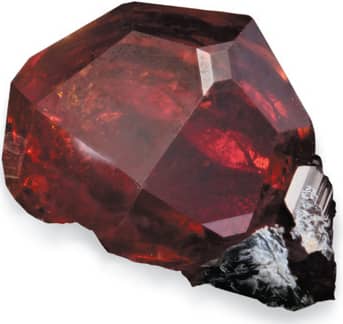
THE CRYSTAL
 Hessonite is also called the cinnamon stone, not only for its color, but because it originates in Sri Lanka, once the greatest spice trader with the West. A gem variety of garnet, its beauty is renowned. Mineralogists named this variety of garnet from the Greek word hesson, meaning “inferior,” because its structure is less dense than other garnets.
Hessonite is also called the cinnamon stone, not only for its color, but because it originates in Sri Lanka, once the greatest spice trader with the West. A gem variety of garnet, its beauty is renowned. Mineralogists named this variety of garnet from the Greek word hesson, meaning “inferior,” because its structure is less dense than other garnets.
LEGENDARY USES
Hessonite garnet is a major crystal used in the Vedic astrological tradition. The nine planetary gemstones, which correspond to and therefore “carry” the energy of the planet concerned, are: ruby, diamond, pearl, red coral, blue sapphire, cat's eye, yellow sapphire, emerald, and hessonite garnet. Hessonite, known in Sanskrit as gomeda (“cow fat”), is the stone associated with Rahu, which, in the Hindu tradition, is the moon's ascending node. A negatively placed Rahu in an astrological birth chart signifies that the individual is deluded by insatiable worldly desires and sensual gratification! Luckily, wearing or carrying hessonite dissolves its own negative energy.
ATTRIBUTES AND POWERS
Vedic (Hindu) astrologers believe that wearing a hessonite garnet of at least two carats can promote success, wealth, and recognition. And, since ancient times, Hessonite is thought to bestow the wearer with longevity and to attract good fortune. It is a fabulous stone for attracting success, particularly in any independent or newly formed business. It also enhances creative thinking, or projects for finding a niche in the market. With this stone you can be sure of attracting the right kind of mentors to you, and for being in the right place at the right time to seize any opportunity.
HOWLITE
APPEARANCE/COLOR: White, green, mottled gray
CURRENT AVAILABILITY: Common
PHYSIOLOGICAL CORRESPONDENCE: Nervous system
PSYCHOLOGICAL CORRESPONDENCE: Creative potential
ASSOCIATED CRYSTALS BY COLOR: White aragonite, petalite
KEYWORDS: Charisma and self-confidence
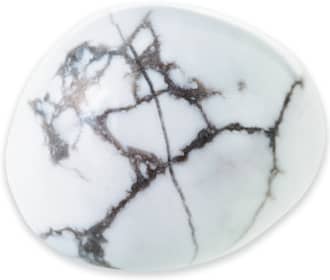
THE CRYSTAL
 Howlite is a borate mineral, and is mostly found in California as well as Mexico, Russia, and Turkey. Natural howlite is always white or gray, and, undyed, its porcelain-like glow is attractive. However, because of its highly porous strucure, it is often dyed to resemble other stones.
Howlite is a borate mineral, and is mostly found in California as well as Mexico, Russia, and Turkey. Natural howlite is always white or gray, and, undyed, its porcelain-like glow is attractive. However, because of its highly porous strucure, it is often dyed to resemble other stones.
LEGENDARY USES
There is no known legends surrounding this stone. It wasn't discovered until the 19th century, in Nova Scotia, by Canadian mineralogist Henry How, for whom the stone was named. The strange, smooth stone is found in its original state in large cauliflower-like masses. Its natural color is white with gray and black veins. Dyed with rich hues it can resemble turquoise, lapis lazuli, or even red coral.
ATTRIBUTES AND POWERS
Howlite is known for its strong associations with self-awareness, creativity, and improving one’s emotional well-being. Wearing the stone enhances charisma, character and strengthens one's self-confidence and self-love. For manifesting success, it allows you to work with your talents and potentials, rather than assume you must do as others do. Howlite dispels selfish or idealistic dreams, and asks you to look inside yourself for the truth. When used in grids or layouts to increase business success, it will help you communicate with discretion, without provoking confrontations.
IOLITE
APPEARANCE/COLOR: Violet, blue, gray, yellow
CURRENT AVAILABILITY: Available from specialty stores
PHYSIOLOGICAL CORRESPONDENCE: Liver, respiratory system
PSYCHOLOGICAL CORRESPONDENCE: Clarity, focus
ASSOCIATED CRYSTALS BY COLOR: Blue calcite, sodalite
KEYWORDS: Freedom from the chains of expectation
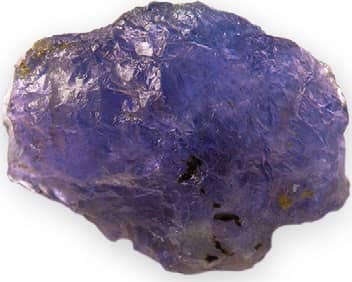
THE CRYSTAL
 Iolite appears as violet-blue or indigo but, looked at from a different angle, it may change to a yellow or gray, a phenomenon known as pleochroism. The name iolite comes from the Greek word ios, meaning violet, and this stone is also sometimes knows as “water sapphire.”
Iolite appears as violet-blue or indigo but, looked at from a different angle, it may change to a yellow or gray, a phenomenon known as pleochroism. The name iolite comes from the Greek word ios, meaning violet, and this stone is also sometimes knows as “water sapphire.”
LEGENDARY USES
It is believed that iolite may be the true stone of the Vikings, used by Leif Eriksson and other explorers when trying to discover the New World. Far away from the coastline they used thin pieces of iolite to navigate and determine their direction, particularly during cloud cover, to work out their position. Looking through an iolite lens, they could determine the exact position of the sun and navigate safely to the New World. Light scattered by water molecules (i.e. clouds, fog, or rain) is polarized. These early navigators worked out that direction of the polarization is at right angles to a line to the sun, even when the sun is obscured by dense fog or lies just below the horizon.
ATTRIBUTES AND POWERS
Iolite is a great stone to restore any lack of confidence so you can brazen forth on the road to success. Wearing or carrying the stone will strengthen your resolve to take on any additional responsibility, enhancing endurance in any adverse situations. If you fee that luck hasn't been on your side, or that you're cursed with negative people or situations, iolite restores a sense of perspective. It also turns chaos to order, and promotes a calm, positive state of mind. Instilling belief and strong decision-making abilities, it also enables you to have a clearer perspective on what success really means to you. As a manifestation stone, Iolite activates creative self-expression, and can bring you fantastic ideas that may be radical or unconventional, but at the same time, trendsetting.
IRON PYRITE
APPEARANCE/COLOR: Gold, brown
CURRENT AVAILABILITY: Common
PHYSIOLOGICAL CORRESPONDENCE: Bloodstream, digestive system
PSYCHOLOGICAL CORRESPONDENCE: Self-worth, confidence
ASSOCIATED CRYSTALS BY COLOR: Goldstone, yellow jasper
KEYWORDS: Willpower, dynamic action
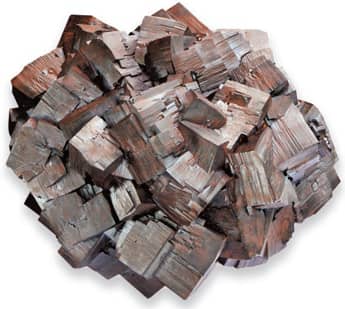
THE CRYSTAL
 Derived from the Greek word pyr, meaning “fire,” iron pyrite was named for its ability to emit sparks when pieces were struck against each other. An iron sulphide mineral, pyrite is commonly found around the world as a constituent of metamorphic rock.
Derived from the Greek word pyr, meaning “fire,” iron pyrite was named for its ability to emit sparks when pieces were struck against each other. An iron sulphide mineral, pyrite is commonly found around the world as a constituent of metamorphic rock.
LEGENDARY USES
Known more commonly as “fool's gold,” the glittering rock was mistaken by naïve gold prospectors as real gold. Dishonest mine-owners added it to their mines, convincing people to dig and walk away with nothing more than fool's gold. Pyrite is harder and more brittle than real gold, and it can’t be scratched with a fingernail or knife. In medieval Germany it was known as “cat’s gold” and throughout Europe it has been favored as a decorative stone, carved to make shoe buckles, rings, snuff boxes, and other items of ornament. In France it is still known as pierre de santé, meaning “stone of health,” due to its positive healing powers.
ATTRIBUTES AND POWERS
As sparkling as the stone itself appears, when worn or carried, pyrite bestows you with vitality, will, and dynamic action. This is a crystal that will enable you to tap into your talents, and stimulate success-making ideas. Enhancing confidence and a determination to carry things through to completion, pyrite can be used to manifest all forms of success, from career to wealth, success in love, to improving health. The stone encourages leadership qualities and is a great ally if you're working toward some kind of promotion. As a truth stone, pyrite promotes clarity and insight, encouraging you to overcome doubt and take action, and be more dynamic and confident.
JADE (RED)
APPEARANCE/COLOR: Red
CURRENT AVAILABILITY: Common
PHYSIOLOGICAL CORRESPONDENCE: Sex organs
PSYCHOLOGICAL CORRESPONDENCE: Passion, motivation
ASSOCIATED CRYSTALS BY COLOR: Garnet, ruby
KEYWORDS: Getting what you desire
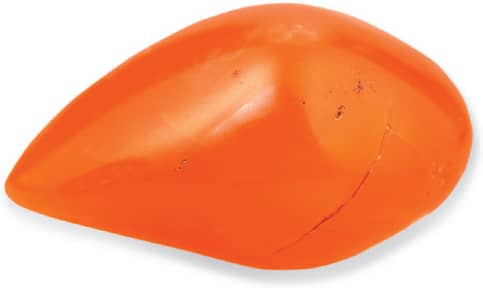
THE CRYSTAL
 Red jade is a variety of jadeite, one of two distinctly different minerals that share the name jade (see here). Jadeite is hard and lustrous, rarer than the softer form, nephrite, and usually more expensive.
Red jade is a variety of jadeite, one of two distinctly different minerals that share the name jade (see here). Jadeite is hard and lustrous, rarer than the softer form, nephrite, and usually more expensive.
LEGENDARY USES
Jade has been used since ancient times in the Far East as a stone to boost and enhance all forms of success in business and in love. However, red jade corresponds to the color of passion, courage, and achievement. The third-century BCE Emperor Qin Shi Huang decorated many of his palace chambers with red jade, believing that would not only enhance his passionate desires, but bring him great wealth, success in war, and many heirs.
ATTRIBUTES AND POWERS
Red jade is a stone which is said to enhance the energy of the warrior. It is a talisman of individual power, dispelling all fear, worry, or doubt. Wearing or carrying the stone prevents you from holding back and urges you to take action. A stone of physical vitality, strength and passion, it stimulates and vitalizes your physical energy, while stabilizing your state of mind. Red jade promotes passionate ideas, and attracts success, but also makes tasks less complex and easier to deal with simply because you have the courage of your convictions to take control of any event. Dark red crystals embody strong, deep feelings, serious thinking, and cool passion.
JASPER (YELLOW)
APPEARANCE/COLOR: Yellow
CURRENT AVAILABILITY: Common
PHYSIOLOGICAL CORRESPONDENCE: Digestive system
PSYCHOLOGICAL CORRESPONDENCE: Intellectual acumen
ASSOCIATED CRYSTALS BY COLOR: Yellow jade, yellow moonstone
KEYWORDS: Successful outcome, achievement

THE CRYSTAL
 Found worldwide, yellow jasper is a variety of quartz. The presence of iron in its structure gives it a tawny yellow color and it often contains other minerals that create rich patterns and veining, as in the variety known as spider jasper.
Found worldwide, yellow jasper is a variety of quartz. The presence of iron in its structure gives it a tawny yellow color and it often contains other minerals that create rich patterns and veining, as in the variety known as spider jasper.
LEGENDARY USES
Yellow jasper was historically revered as a talisman of protection and discernment, and has been used by priests, shamans, and magicians to aid and protect them when venturing into the metaphysical world. To the native North American peoples, spider jasper (a variety containing earthy white or dark brown spiderweb markings) is believed to contain the power of the wise Grandmother Spider. The Grandmother Spider created people from four different-colored clays as the four nations of the Earth, then led them out from the darkness where Grandfather Sun breathed life into them.
ATTRIBUTES AND POWERS
Wearing yellow or spider jasper builds self-confidence and enthusiasm, and channels positive energy to attract others to you. For forming good contacts, and making a success in business, carry a piece of yellow jasper to improve all communication channels. It also promotes inner strength and mental clarity, and its stabilizing energy keeps you logical and realistic in times of stress. Yellow jasper also gives you the tenacity and perseverance to overcome any obstacles and to move defiantly toward any achievement. A crystal of the intellect, the stone is an excellent crystal for the workplace to encourage the completion of tasks that may have been put on the backburner.
LEPIDOLITE
APPEARANCE/COLOR: Purple, pink
CURRENT AVAILABILITY: Widely available
PHYSIOLOGICAL CORRESPONDENCE: Connective tissues
PSYCHOLOGICAL CORRESPONDENCE: Change, transition
ASSOCIATED CRYSTALS BY COLOR: Purple sapphire, chariote
KEYWORDS: Self-respect, self-reliance
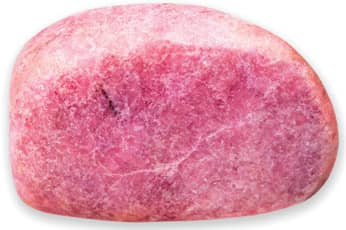
THE CRYSTAL
 A type of mica, lepidolite often occurs in sparkling masses surrounding pink tourmaline stones. Rich in lithium, the stone can be lavender, purple, and pink, sparkling with a pinkish glow in its polished form.
A type of mica, lepidolite often occurs in sparkling masses surrounding pink tourmaline stones. Rich in lithium, the stone can be lavender, purple, and pink, sparkling with a pinkish glow in its polished form.
LEGENDARY USES
The name derives from the Greek word lepidos, meaning “scale,” due to the scaly constituents that surround it. As a recently newly discovered stone for the New Age movement there is no current legendary information about lepidolite.
ATTRIBUTES AND POWERS
Believed to calm the mind and remove negativity, lepidolite is a great stone for restoring self-value. A stone of acceptance and trust, it provides the wearer with a sense that they can now let go of the past and move into a new phase or new beginning in their life. When working with this stone, all transitions become positive ones, and as a stone of manifesting success, lepidolite attracts the right kind of change. Activating dynamic and yet disciplined energy, you will soon realize that your long-term goals are in sight. Also with its ability to enhance an independent spirit, the stone not only helps to attract supportive friends, contacts, and colleagues, but brings you a wealth of opportunities to succeed.
MOLDAVITE
APPEARANCE/COLOR: Dark green
CURRENT AVAILABILITY: Expensive and increasingly rare
PHYSIOLOGICAL CORRESPONDENCE: Holistic
PSYCHOLOGICAL CORRESPONDENCE: Deep awareness of self
ASSOCIATED CRYSTALS BY COLOR: Malachite, green tourmaline
KEYWORDS: Transformative power, good fortune
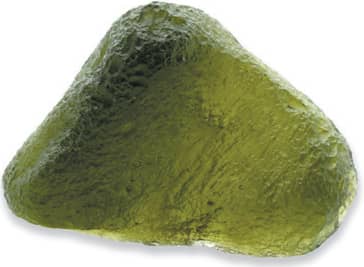
THE CRYSTAL
 Moldavite is a form of tektite, a crystal structure believed to be extraterrestrial because it is usually found where meteorites impacted the Earth millions of years ago. Moldavite is specific to such an event which occurred in what is now southern Germany, and is only found in the region of the River Moldau where it flows through southern Germany and Czechoslovakia. Translucent dull-green moldavite is unlike other tektites, which are usually a slimy brown.
Moldavite is a form of tektite, a crystal structure believed to be extraterrestrial because it is usually found where meteorites impacted the Earth millions of years ago. Moldavite is specific to such an event which occurred in what is now southern Germany, and is only found in the region of the River Moldau where it flows through southern Germany and Czechoslovakia. Translucent dull-green moldavite is unlike other tektites, which are usually a slimy brown.
LEGENDARY USES
Found in archeological sites in central Europe dating back to the Stone Age, moldavite was used not only for arrowheads and cutting tools but as an amulet of good fortune, fertility, and protection. In medieval European folklore, moldavite was given as a betrothal gift to bring harmony to the married couple.
ATTRIBUTES AND POWERS
Carrying or wearing moldavite strengthens your ability to see the “cosmic” viewpoint rather than the narrow, rigid, earthbound one. Because of its intense vibration, the stone links you to higher planes of consciousness and, some say, extraterrestrials, enhancing your intuitive and universal connection. On a more practical note, moldavite counteracts cynicism and enables you to see success on many levels. It is a stone of good fortune, and solves money worries by providing solutions not previously considered. This unconventional stone inspires unexpected solutions and new directions to achieve one's dreams.
RHYOLITE
APPEARANCE/COLOR: Mottled green and brown
CURRENT AVAILABILITY: Common
PHYSIOLOGICAL CORRESPONDENCE: Skin
PSYCHOLOGICAL CORRESPONDENCE: Determination
ASSOCIATED CRYSTALS BY COLOR: Howlite, serpentine
KEYWORDS: Fast progress toward success
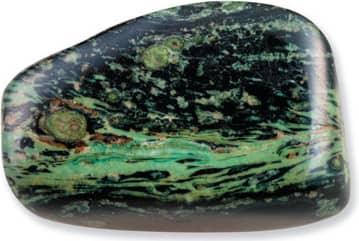
THE CRYSTAL
 Rhyolite is found in igneous rock made up of volcanic silica-rich magma. It belongs to the same rock class as granite and is common around the globe. Rhyolite is the name of a ghost town on the western edge of a volcanic field, which includes Death Valley, in southwestern Nevada.
Rhyolite is found in igneous rock made up of volcanic silica-rich magma. It belongs to the same rock class as granite and is common around the globe. Rhyolite is the name of a ghost town on the western edge of a volcanic field, which includes Death Valley, in southwestern Nevada.
LEGENDARY USES
Although there are no specific legends for rhyolite, perhaps just as meaningful is the history surrounding the ghost town of Rhyolite, which in a way reflects the stone's ability to “rush quickly toward success.” In fact, ironically rhyolite wasn’t the reason for the “rush,” but the discovery of gold among the rhyolitic lava flows. Within this area, gold-rush settlements quickly arose near the new mines, and the town of Rhyolite became the largest and most successful, albeit shortlived; eventually the mines went bust, and the town fell into ruin around 1912.
ATTRIBUTES AND POWERS
Considered a stone of resolution, rhyolite is best known for its ability to promote integrity, determination, and to balance one's life for successful outcomes. While it helps you fulfill your goals or make your dreams come true, it also aids in discovering what your true life journey is all about. Carry rhyolite when you know you may have to face difficult customers or clients or confront people who may try to put you off your course. This stone will help you not to rush into things without forethought, but still get you moving toward your goal so things don't stagnate. It enhances a shift in perception, and encourages you to move forward with your dreams.
RUBY
APPEARANCE/COLOR: Red
CURRENT AVAILABILITY: Uncut widely available, polished gemstone expensive but available
PHYSIOLOGICAL CORRESPONDENCE: Blood and circulatory system
PSYCHOLOGICAL CORRESPONDENCE: Courage, passion, enthusiasm
ASSOCIATED CRYSTALS BY COLOR: Garnet, cinnabar
KEYWORDS: Dynamic success, abundant wealth
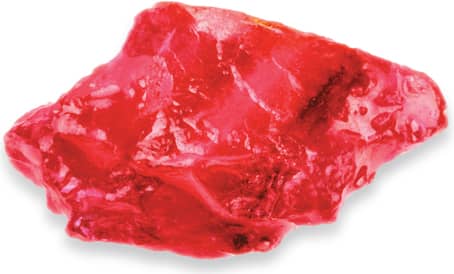
THE CRYSTAL
 Ruby is red corundum, an aluminum oxide mineral with chromium responsible for its rich, red color. The name ruby comes from the Latin word rubeus, meaning “red.” It wasn't until 1800 that ruby was recognized as a separate stone from red spinels, tourmalines, and garnets. These were all previously thought to be ruby.
Ruby is red corundum, an aluminum oxide mineral with chromium responsible for its rich, red color. The name ruby comes from the Latin word rubeus, meaning “red.” It wasn't until 1800 that ruby was recognized as a separate stone from red spinels, tourmalines, and garnets. These were all previously thought to be ruby.
LEGENDARY USES
A symbol of passion, wealth, prosperity, and protection, the Mongolian Emperor Kublai Khan was said to have offered an entire city in exchange for a sizeable ruby. Symbolizing the sun, its glowing hue was thought to be an inextinguishable flame within the stone. Ancient Chinese legends claim the ruby would shine through even the thickest clothing and could never be hidden; while the ancient Greeks cast ruby into water to make it boil. To protect them from invading Mongols, 13th-century Burmese warriors inserted rubies into their navels, believing this would make them invincible. Sadly even the ruby could not save them.
ATTRIBUTES AND POWERS
Although an aphrodisiacal stone of passionate love, the ruby also promotes a clear mind, increased concentration, and motivation. Bestowing you with a sense of power, it enhances self-confidence and determination and guides you quickly toward prosperity and achievement. Rubies are success stones, in that they incite passion for a goal, ignite love for what and who one is, and intensify one's desire to win at all costs. It is said that provided you keep with you the smallest piece of ruby, wealth will never depart. The stone promotes the maxim of “following your bliss,” and enables you to live with passion as your greatest guide.
SAPPHIRE (BLACK)
APPEARANCE/COLOR: Black
CURRENT AVAILABILITY: Available from specialty stores
PHYSIOLOGICAL CORRESPONDENCE: Blood, circulatory system
PSYCHOLOGICAL CORRESPONDENCE: Confidence, courage
ASSOCIATED CRYSTALS BY COLOR: Onyx, obsidian
KEYWORDS: Attracts prosperity and successful enterprises
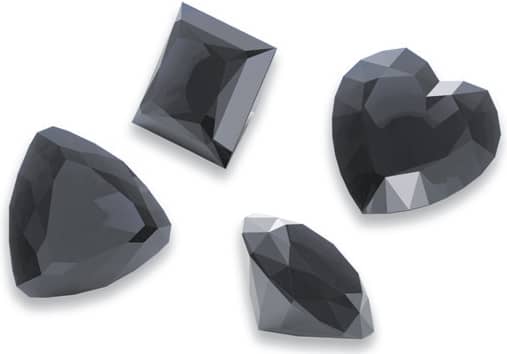
THE CRYSTAL
 Found mostly in Australia, black sapphire is an opaque variety of corundum. Less prized than blue or yellow sapphires, this black stone is often confused with onyx. But black sapphire is much harder in quality than onyx and, to the mineral experts, more useful for gemstone cutting purposes.
Found mostly in Australia, black sapphire is an opaque variety of corundum. Less prized than blue or yellow sapphires, this black stone is often confused with onyx. But black sapphire is much harder in quality than onyx and, to the mineral experts, more useful for gemstone cutting purposes.
LEGENDARY USES
Black sapphire was used by ancient Greek necromancers, magicians, and witches as an oracle stone to foretell the future. Setting it on an altar, it was thought to have the power to channel the wisdom of the spirit world. The stone was also used in talismanic magic to cast spells or held by high priestesses of Apollo's temple at Delphi to empower them with oracular power. In ancient Egypt it was considered a stone of spiritual power and astuteness, attracting prosperity and protection when in the possession of pharaohs and royalty.
ATTRIBUTES AND POWERS
This beautiful black stone enables you to stay centered when all about you are in chaos. If you are overly sensitive to other people's conflicts of opinions or disputes, wearing or carrying black sapphire will give you the confidence to see what, if any, opportunity can be made out of deadlocks and difficult decisions, while still allowing others to take responsibility for problems of their own making. This stone enhances intuition, clarity, and self-mastery and is the ideal sapphire for grounding ideas and bringing things through to completion. Deflecting negativity, the stone will also attract success to you if you are focused and sure of your positive intention.
SAPPHIRE (YELLOW)
APPEARANCE/COLOR: Yellow or golden
CURRENT AVAILABILITY: Available from specialty stores
PHYSIOLOGICAL CORRESPONDENCE: Detoxifier
PSYCHOLOGICAL CORRESPONDENCE: Intellectual power
ASSOCIATED CRYSTALS BY COLOR: Citrine, yellow jade
KEYWORDS: The stone to “sell your success”
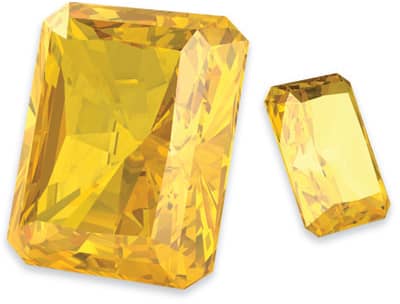
THE CRYSTAL
 Found in Australia, Madagascar, Thailand, and Sri Lanka, the yellow sapphire is, like other corundum gems, an aluminum oxide. Next to the diamond, it is the second hardest gemstone. On the gemstone relative hardness scale, known as the Mohs Scale, at the top end at 10 is the diamond. Descending the scale shows which gemstone can scratch the one below it (but not above it). On this scale the sapphire is second to the diamond.
Found in Australia, Madagascar, Thailand, and Sri Lanka, the yellow sapphire is, like other corundum gems, an aluminum oxide. Next to the diamond, it is the second hardest gemstone. On the gemstone relative hardness scale, known as the Mohs Scale, at the top end at 10 is the diamond. Descending the scale shows which gemstone can scratch the one below it (but not above it). On this scale the sapphire is second to the diamond.
LEGENDARY USES
To the Hindus, the yellow sapphire is the legendary helper of their god Ganesh. By propitiating Ganesh, yellow sapphire attracts literal wealth. Throughout the ages, merchants in India and the Far East have worn or carried fine yellow sapphire to enhance their business success. Legends tell that, when worn, a portion of the stone must touch the body for its powers to work. In ancient Chinese culture, people were buried with yellow sapphire placed in their mouths to insure wealth in the next life. Once known as oriental topaz, the yellow sapphire was a status symbol of wisdom and leadership.
ATTRIBUTES AND POWERS
Yellow sapphire not only attracts wealth and financial abundance, but manifests your creative energy. It stimulates the intellect, helping you to formulate ideas and goals, promotes focus and concentration, and encourages exploration, new directions, and joyful expectation. The stone brings clarity, zest, optimism, and meaning to all that you do. The lighter yellow sapphires ensure that all new relationships get off to a good start. Darker yellow stones are excellent to hold or carry when you need to make a positive choice or persuade others. Often described as the “salesman’s stone,” the yellow sapphire will bestow you with the power to sell anything.
SEPTARIAN
APPEARANCE/COLOR: Mix of yellow, brown, gray
CURRENT AVAILABILITY: Available but expensive
PHYSIOLOGICAL CORRESPONDENCE: Metabolism
PSYCHOLOGICAL CORRESPONDENCE: Positive communication
ASSOCIATED CRYSTALS BY COLOR: Serpentine, brown tourmaline
KEYWORDS: The “speaker's stone,” charismatic presence
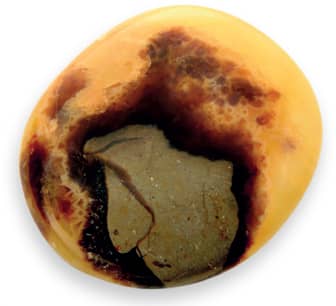
THE CRYSTAL
 Septarian is a geode that is made up of a combination of different minerals which include calcite, aragonite, limestone, and barite. A sedimentary fossil stone, it formed as a colony of small microorganisms, similar to the polyps of coral, which give it a characteristic look of a turtle's shell. Although widely available, it occurs naturally only in Utah, Madagascar, and Morocco.
Septarian is a geode that is made up of a combination of different minerals which include calcite, aragonite, limestone, and barite. A sedimentary fossil stone, it formed as a colony of small microorganisms, similar to the polyps of coral, which give it a characteristic look of a turtle's shell. Although widely available, it occurs naturally only in Utah, Madagascar, and Morocco.
LEGENDARY USES
Also known as septaria, it takes its name from the Latin word for seven, septem, or saeptum, meaning “wall or enclosure.” Millions of years ago volcanic activity disturbed the seabed and all marine life was destroyed. As the volcanic mass crashed to the seabed, mudballs formed from the various components of calcite, aragonite, limestone, and barite. As these mudballs solidified, seven fissures or wall-like cracks radiated out from the center, giving the stone, according to some, its “dragon skin” appearance. This appearance has also given rise to its legendary name of “dragon stone.”
ATTRIBUTES AND POWERS
Septarian brings calming and nurturing energies and promotes feelings of joy and vitality. Used to enhance all kinds of communication, it is particularly treasured as a stone to promote brilliant public speaking. It bestows you with confidence, charisma, and an astute choice of words so that others truly listen to what you have to say too. In this way your effortless communication attracts success in whatever field you are seeking. When we change our beliefs, and change the way we communicate those beliefs, we change our world too. This stone helps you to do just that.
TOURMALINE (BLACK)
APPEARANCE/COLOR: Black, dark blueish-black
CURRENT AVAILABILITY: Widely available
PHYSIOLOGICAL CORRESPONDENCE: Brain, mental processes
PSYCHOLOGICAL CORRESPONDENCE: Rational thought, clear mind
ASSOCIATED CRYSTALS BY COLOR: Onyx, jet
KEYWORDS: Positive attitude toward success
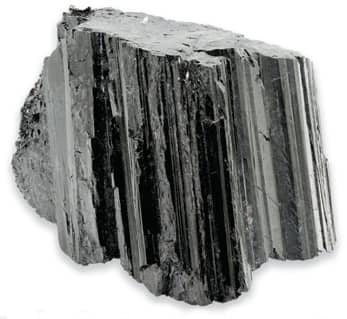
THE CRYSTAL
 Black tourmaline, also known as schorl, accounts for 95 percent of all naturally occurring tourmaline. The word "schorl" was in use before the 15th century and was taken from the name of a town in Saxony, Germany, where the mineral was first found in tin mines.
Black tourmaline, also known as schorl, accounts for 95 percent of all naturally occurring tourmaline. The word "schorl" was in use before the 15th century and was taken from the name of a town in Saxony, Germany, where the mineral was first found in tin mines.
LEGENDARY USES
Early medieval European magicians relied upon black tourmaline, then known as schorl, to protect them from earth demons as they cast their spells. Today this stone is still considered a talisman of protection, providing a psychic shield deflecting and dispelling negative energies, entities, or destructive forces. Used by shamans of the African, Native American, and Aboriginal peoples, black tourmaline was thought to bring healing powers to the user and provide protection from all physical danger.
ATTRIBUTES AND POWERS
With its highly protective qualities, black tourmaline enables you to maintain a positive attitude toward your goals and desires, never letting you lose your commitment to your purpose or future prospect. Wearing or carrying the stone increases physical vitality and promotes an objective view of the world and everyone in it—including yourself. It also guards against electromagnetic negativity and geopathic stress. Black tourmaline is a powerful grounding stone, promoting a sense of power and self-confidence. It will enable you to see success “written in stone” in any long-term goal, and see you through any challenging encounters.
CRYSTALS for WELL-BEING/HOME
Probably the most popular use for crystals is to manifest well-being and ensure our home and surrounding environment are in harmony. To manifest this, though, requires specific crystals which can enhance and balance our home, protect us from outside negativity, and also establish a deeper connection to the universal energy to make things happen as we want them to.
We can place a grid of crystals around the home to protect it from geopathic or other electromagnetic stresses. We can carry, wear, and use crystals to perform rituals to help heal us emotionally or bring balance to mind, body, and spirit. Whatever you consider your personal well-being to consist of, and whatever you believe creates harmony and happiness in the home, these crystals will help you to manifest exactly those intentions.

AEGIRINE
APPEARANCE/COLOR: Greenish brown to black
CURRENT AVAILABILITY: Available
PHYSIOLOGICAL CORRESPONDENCE: Immune system
PSYCHOLOGICAL CORRESPONDENCE: Self-reliance
ASSOCIATED CRYSTALS BY COLOR: Malachite, seraphinitet
KEYWORDS: Protection and strength of convictions
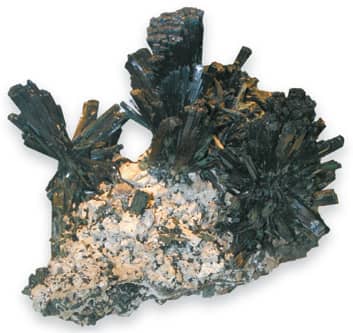
THE CRYSTAL
 Aegirine is a sodium iron silicate, forming long prismatic or flat crystals ending in an irregular-shaped pyramid. Found principally in Malawi, Canada, Greenland, Russia, and Norway, the stone is usually opaque, but sometimes appears translucent. It is also known as acmite, from the Greek word meaning "point," due to its extremely sharp ends.
Aegirine is a sodium iron silicate, forming long prismatic or flat crystals ending in an irregular-shaped pyramid. Found principally in Malawi, Canada, Greenland, Russia, and Norway, the stone is usually opaque, but sometimes appears translucent. It is also known as acmite, from the Greek word meaning "point," due to its extremely sharp ends.
LEGENDARY USES
Discovered in Norway in the 19th century, aegirine was named after Aegir, the Norse giant of the sea, who was known to hold lavish feasts to appease the gods.
In Norse legend, wearing an aegerine amulet was thought to cure frostbite or warm the heart of those who had been betrayed or rejected in love. In Russian folklore the stone was placed beside the hearth of the home to bestow the power of the gods directly on to the family patriarch.
ATTRIBUTES AND POWERS
A stone of integrity, aegirine aligns you to your convictions and values, and gives you the confidence to follow those convictions. Black is the color of protection and invisibility. By correspondence, the stone enables you to get on with your life free from self-sabotage or malice or spite from rivals or enemies. Aegirine activates a strong, protective energy, guarding your aura and physical body. It eliminates negative thoughts and attachments, and replaces them with positive energy. Wearing the stone promotes power and strength, and relieves phobias or fears associated with human mortality. Like the giant Aegir in his feasting hall, the stone is a powerful protector against geopathic stress and/or psychic attack from others.
AMBER
APPEARANCE/COLOR: Golden, yellow, brown
CURRENT AVAILABILITY: Common
PHYSIOLOGICAL CORRESPONDENCE: Throat
PSYCHOLOGICAL CORRESPONDENCE: Positive thinking, stability
ASSOCIATED CRYSTALS BY COLOR: Goldstone, golden topaz
KEYWORDS: Peace, balance, wholeness
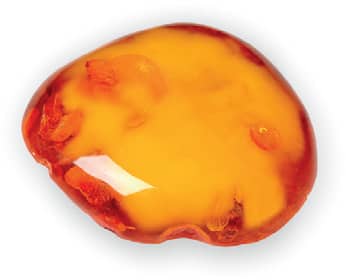
THE CRYSTAL
 Transparent amber is fossilized tree resin and is usually found in irregularly shaped nodules or masses. It often contains small insects or plant specimens that were trapped millions of years ago before the resin had solidified. The amber becomes stabilized by undergoing chemical changes after it has been buried in the ground.
Transparent amber is fossilized tree resin and is usually found in irregularly shaped nodules or masses. It often contains small insects or plant specimens that were trapped millions of years ago before the resin had solidified. The amber becomes stabilized by undergoing chemical changes after it has been buried in the ground.
LEGENDARY USES
Amber has been prized since ancient Egyptian times for jewelry, talismans, amulets, and even goblets. Today, most amber is sourced from the shores of the Baltic Sea, where pine trees that exude the resin have formed the region’s natural vegetation for millions of years. In Scandinavia, amber was believed to be the tears of Freyja, the Viking goddess of love and beauty. Because it is not a true stone, amber's natural warmth was deemed by some cultures to be a sign that it was a living being. In the Far East, for example, it was believed the souls of tigers metamorphosed into amber at their death and brought courage to anyone who wore the crystal.
ATTRIBUTES AND POWERS
Due to its electrostatic powers, amber is considered to be one of the most effective energy-healing crystals. It draws away toxins, pain, and disease from the body, stimulating the immune system and other natural healing mechanisms. When worn, the stone is a superb all-round crystal for well-being. Placed in the home it is also a natural purifier, absorbing negative or stagnant energy and transforming it into positive energy. Amber is also ideal for cleansing and reactivating the chakras, and is a great stone for manifesting harmony and peace at home.
AMETHYST
APPEARANCE/COLOR: Purple, violet, lavender
CURRENT AVAILABILITY: Easily available
PHYSIOLOGICAL CORRESPONDENCE: Endocrine system
PSYCHOLOGICAL CORRESPONDENCE: Mental focus, decision-making, motivation
ASSOCIATED CRYSTALS BY COLOR: Charoite, azurite
KEYWORDS: All-healing, protection, imagination, insight
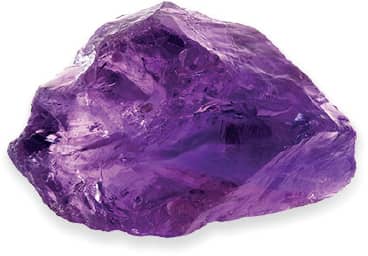
THE CRYSTAL
 Amethyst is a variety of quartz that forms as transparent, terminated crystals of all sizes whether as geodes, clusters, or single terminations. It is the presence of manganese in the clear quartz that produces amethyst's well-known color.
Amethyst is a variety of quartz that forms as transparent, terminated crystals of all sizes whether as geodes, clusters, or single terminations. It is the presence of manganese in the clear quartz that produces amethyst's well-known color.
LEGENDARY USES
Ancient Greeks and Romans routinely studded their goblets with this beautiful purple crystal, believing the wine drunk from the cup would then be powerless to intoxicate them. Throughout history, amethyst has been highly esteemed for its stunning beauty and legendary powers to stimulate and soothe the mind and emotions. In the Egyptian Book of the Dead, it was carved into heart-shaped amulets for burial with the dead. In many Eastern cultures, it was used in temple offerings for worship, or to align with planetary and astrological influences.
ATTRIBUTES AND POWERS
The true stone of spiritual healing and enlightenment, amethyst is often used by mystics, psychics, healers, and religious leaders for its intuitive, transcendent, and spiritually restoring properties and its ability to awaken the crown and spirit chakras. Amethyst helps to stir your imagination and intuitive powers, refining thought and stimulating new ideas. It is an excellent stone for merging spiritual understanding with practical common sense. Reputed to remove evil thoughts and increase intelligence, it also enhances your creativity and passion for life. Its calming influence on the mind promotes peace, love, courage, and spiritual happiness.
BLOODSTONE
APPEARANCE/COLOR: Red-green
CURRENT AVAILABILITY: Widely available
PHYSIOLOGICAL CORRESPONDENCE: Lymph glands
PSYCHOLOGICAL CORRESPONDENCE: Flexibility, self-reliance
ASSOCIATED CRYSTALS BY COLOR: Green chalcedony, spider jasper
KEYWORDS: Living in the here and now, vitality
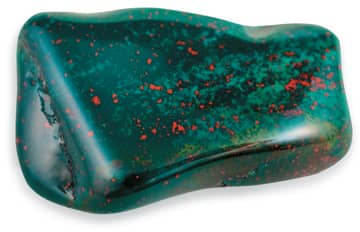
THE CRYSTAL
 Although sometimes referred to as heliotrope, bloodstone is defined as a dark green chalcedony with blood-like spots of red jasper or iron oxide inclusions. Heliotrope is translucent, whereas bloodstone is generally opaque with a waxy, resinous luster. It is mainly found in Armenia, India, Brazil, and the USA.
Although sometimes referred to as heliotrope, bloodstone is defined as a dark green chalcedony with blood-like spots of red jasper or iron oxide inclusions. Heliotrope is translucent, whereas bloodstone is generally opaque with a waxy, resinous luster. It is mainly found in Armenia, India, Brazil, and the USA.
LEGENDARY USES
Known in antiquity as heliotrope, from the Greek words helios, meaning “sun,” and trepein, “to attract,” one ancient Greek legend recounts how the sun god, Helios, was tempted to leave the heavens forever and come down to earth when he fell in love with a mortal woman. Its use for healing, and its connection with purifying the blood can be traced back five thousand years to Mesopotamian legends. Dipped in cold water and placed on the body to aid circulation, it could transfer the power of the sun to prevent injury or disease.
ATTRIBUTES AND POWERS
Bloodstone has long been a talisman of good health and long life, and was said to bring its owner respect, good fortune, riches, and fame. It was also believed to have magical properties, including the ability to control the weather by averting lightning, conjuring storms, or summoning rain. The stone promotes self-reliance, the ability to adapt to changing circumstances, and to live in the present rather dwell on the past or worry about the future. Bloodstone calms your emotions, dispels confusion, and enhances decision-making. It is a great stone to enhance self-worth, self-confidence, and self-sufficiency.
CAXOCENITE
APPEARANCE/COLOR: Golden brown, yellowish brown
CURRENT AVAILABILITY: Available but expensive
PHYSIOLOGICAL CORRESPONDENCE: All-round healing
PSYCHOLOGICAL CORRESPONDENCE: Self-confidence, spiritual growth
ASSOCIATED CRYSTALS BY COLOR: Golden topaz, tiger's eye
KEYWORDS: Powerful healing aid for holistic well-being
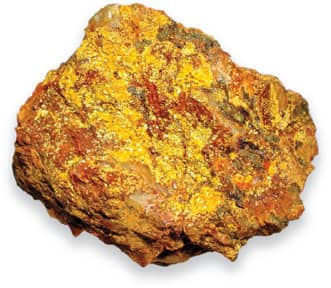
THE CRYSTAL
 Found though out most of Brazil, central Europe, and the USA, the stone is also known as cacoxene or cacoxitite. Caxocenite is a fibrous iron aluminum phosphate mineral with a silky luster and often appears as an inclusion in varieties of quartz such as amethyst.
Found though out most of Brazil, central Europe, and the USA, the stone is also known as cacoxene or cacoxitite. Caxocenite is a fibrous iron aluminum phosphate mineral with a silky luster and often appears as an inclusion in varieties of quartz such as amethyst.
LEGENDARY USES
First discovered in 1825 in a Bohemian mine, there are no legendary uses to date. However, the views of recent spiritual and healing specialists suggest that when it appears as an inclusion in quartz, it tends to amplify and promote a more powerful energy that the host stone alone can provide. So, when it appears in amethyst it increases one's ability to connect to the third-eye and crown chakras, to bring deeper spiritual awareness.
ATTRIBUTES AND POWERS
Cacoxenite in shades of brown promotes stability, patience, honesty, balance, and resourcefulness. It is the perfect energy for placing in the home to enhance any space and to create a comfortable and harmonious environment for yourself, family, and friends. It is also a great stone if you want to feel in control of your life, and protected from outside influences. Associated with the northeast and southwest areas of a home or room, the stone is best placed in these corners to amplify and promote good living. If you come across cacoxenite as an inclusion in amethyst (fairly expensive but beautiful), it will boost all forms of spiritual connection to the universal energy so that you can manifest well-being in every area of your life.
CHAROITE
APPEARANCE/COLOR: Purple
CURRENT AVAILABILITY: Rare and expensive but still available
PHYSIOLOGICAL CORRESPONDENCE: Nervous system
PSYCHOLOGICAL CORRESPONDENCE: Acceptance, self-value
ASSOCIATED CRYSTALS BY COLOR: Sugilite, lepidolite
KEYWORDS: Spontaneity, fresh perspective
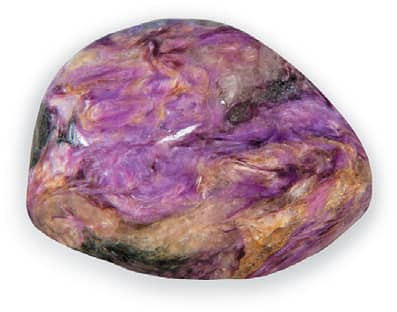
THE CRYSTAL
 A complex fibrous, silicate mineral, with swirls of lavender or violet colors and a pearly luster, its name is derived from the Chara river region in Russia, the only site in the world where it is found. Scientists are still at a loss to know why this is the only location where this rare mineral can be found.
A complex fibrous, silicate mineral, with swirls of lavender or violet colors and a pearly luster, its name is derived from the Chara river region in Russia, the only site in the world where it is found. Scientists are still at a loss to know why this is the only location where this rare mineral can be found.
LEGENDARY USES
As it has only recently been discovered, there are no known legends, although it is believed that since ancient times the indigenous peoples of Siberia have brewed a special tea made from the powdered stone to ward off evil spirits. The Chara river region has now become famous as the location of the charoite deposits mined from the Muran Massif of northwest Aldan in the Sakha Republic or Russia. The purple mineral was originally discovered in the 1940s during the construction of a rail tunnel, but the stone was relatively unknown to mineralogists and the gemstone world until 1978.
ATTRIBUTES AND POWERS
Charoite is often considered to be a “stone of transformation,” turning negative emotions such as anger and fear into positive feelings. Charoite improves analytical abilities and the capacity for keen observation. It assists in decision-making and facilitates faster responses. Its cleansing energy aligns the heart and intellect and allows you to see yourself and others with unconditional love and acceptance. It encourages flexibility and letting go of negative vibrations, and inspires you to move forward in relationships and the way you view the world. Charoite is also beneficial in putting things into perspective and overcoming resistance to change. Wearing the stone helps you to see good possibilities in all situations.
CHIASTOLITE (ANDALUSITE)
APPEARANCE/COLOR: Dark brown, dark gray, red ocher
CURRENT AVAILABILITY: Common
PHYSIOLOGICAL CORRESPONDENCE: Immune system
PSYCHOLOGICAL CORRESPONDENCE: Security, self-awareness
ASSOCIATED CRYSTALS BY COLOR: Smoky quartz, idocrase
KEYWORDS: Grounding, reality check, stress release
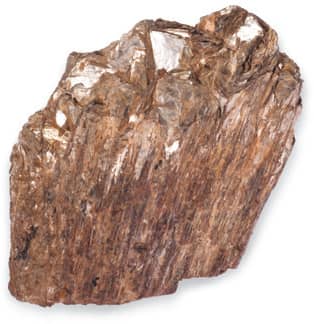
THE CRYSTAL
 Chiastolite is an unusual dark brown stone with a black cross pattern occurring naturally in its structure caused by inclusions of graphite. It is a variety of andalusite, formed from aluminum ciliate in metamorphic rock. Andalusite was first found in Spain, hence its name, but both stones can be found also in Russia, the USA, Brazil, and Canada.
Chiastolite is an unusual dark brown stone with a black cross pattern occurring naturally in its structure caused by inclusions of graphite. It is a variety of andalusite, formed from aluminum ciliate in metamorphic rock. Andalusite was first found in Spain, hence its name, but both stones can be found also in Russia, the USA, Brazil, and Canada.
LEGENDARY USES
Chiastolite probably derives from the Greek word chiastos, meaning “cross marked” or “cruciform.” Sometimes commonly called the “cross stone,” early Christian believers were convinced that finding this stone was a sign that God was on your side. The stone andalusite displays the same structure and coloration, but does not have a cross within it. Also known as the “fairy stone” in medieval lore, chiastolite was considered a good luck charm to protect children from evil spirits. One legend tells that the cross was created by the tears of fairies who were unable to control their crying when they heard of the crucifixion of Jesus.
ATTRIBUTES AND POWERS
This is one of those stones that has many names, and one currently used by New Age healers is the “seeing stone.” Chiastolite brings self-awareness and a non-judgmental attitude to one's own character. Wearing or carrying the stone also helps you to see the truth in other people, situations, and experiences and it also guides you to know what is the right path to follow. Chiastolite helps you see through to the end long-term projects by keeping you completely focused on the task in hand. As a stone of well-being, the stone helps you to become aware that life is in constant flux, and that all of us need to adapt to the changes that occur.
HEMATITE
APPEARANCE/COLOR: Silver-gray, black, brown, blue, red
CURRENT AVAILABILITY: Common
PHYSIOLOGICAL CORRESPONDENCE: Circulation
PSYCHOLOGICAL CORRESPONDENCE: Focus, will, strength
ASSOCIATED CRYSTALS BY COLOR: Apatite, smoky quartz
KEYWORDS: Self-esteem, magnetism, empowerment
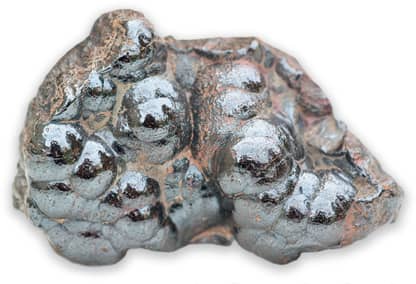
THE CRYSTAL
 Hematite occurs in various colors: black, silver-gray, brown, reddish-brown, or red. It is the main mineral component of iron and varieties include martinet, iron rose and specularite (specular hematite). Found worldwide, and in abundance in the USA and Morocco, the best specimens are found in Cumbria in northwest England, the island of Elba, Italy, and Grischin, Switzerland. Rare prismatic forms occur in Hotazel, South Africa.
Hematite occurs in various colors: black, silver-gray, brown, reddish-brown, or red. It is the main mineral component of iron and varieties include martinet, iron rose and specularite (specular hematite). Found worldwide, and in abundance in the USA and Morocco, the best specimens are found in Cumbria in northwest England, the island of Elba, Italy, and Grischin, Switzerland. Rare prismatic forms occur in Hotazel, South Africa.
LEGENDARY USES
Hematite originates from the Ancient Greek for “blood-red stone,” in reference to the rusty red of its iron ore content. However, when polished, it becomes silvery gray to black, and acts as a magnet. The pigment red ocher is a variety of hematite and has been used extensively by all civilizations for example in ancient cave art, Greek frescos, Indian mandalas, Roman drawings, Native American medicine pouches, and other spiritual symbols. The Roman historian Pliny recounted how hematite in elixir form was, for the Mesopotamians, a cure for eye disorders and liver disease.
ATTRIBUTES AND POWERS
Placed in the home or workplace, hematite is grounding and calming, and it encourages decluttering and efficient organization. It promotes original or logical thinking as well as mental focus and persistence. Emotionally, hematite decreases negativity. By balancing the chakras and bringing harmony to the holistic self it also boosts self-esteem and self-confidence. The stone enables you to come to terms with life and adopt an outlook that sees a glass half full rather than half empty.
HIDDENITE
APPEARANCE/COLOR: Green, yellow-green
CURRENT AVAILABILITY: Widely available
PHYSIOLOGICAL CORRESPONDENCE: Circulation
PSYCHOLOGICAL CORRESPONDENCE: Self-awareness, growth
ASSOCIATED CRYSTALS BY COLOR: Green obsidian, yellow muscovite
KEYWORDS: Compassion, communication, protection
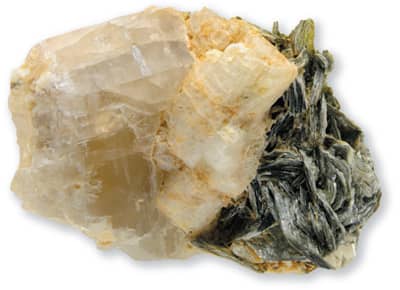
THE CRYSTAL
 Found in Brazil, Myanmar, the USA, and Afghanistan, hiddenite is a variety of spodumene, a silicate, and is named for William Earl Hidden, who first described it in 1879 in North Carolina. Hiddenite, also referred to as green kunzite or lithia emerald, has a glasslike transparency and forms in prismatic crystals.
Found in Brazil, Myanmar, the USA, and Afghanistan, hiddenite is a variety of spodumene, a silicate, and is named for William Earl Hidden, who first described it in 1879 in North Carolina. Hiddenite, also referred to as green kunzite or lithia emerald, has a glasslike transparency and forms in prismatic crystals.
LEGENDARY USES
Although there are few legends due to its recent discovery, the power of this stone is, like emerald associated with its vivid green color. Green has always been a symbol of growth, fertility, prosperity, and abundance. In Chinese Feng Shui, green is associated with the element wood and the east and southeast areas of homes or rooms. The east corresponds to family, health, and well-being, while the southeast is concerned with wealth and abundance. By placing hiddenite in these areas, you will promote the essence of growth in all areas of your life.
ATTRIBUTES AND POWERS
The stone enhances new beginnings and enables you to focus on the present, letting go of the past and not worrying about the future. As a protective stone, hiddenite removes negativity, and dissolves unwanted energies and any distress or negative mental influences. Helping to reconnect loving thoughts and communication, it also recreates heartfelt love in relationships. It can even rekindle a fading romance and bring renewed ardor to a dull relationship. Hiddenite encourages someone to love with a whole heart, allowing them to see that love has no conditions and what you give out to another person is what you will receive back in kind.
JASPER, GREEN
APPEARANCE/COLOR: Various shades of green
CURRENT AVAILABILITY: Widely available
PHYSIOLOGICAL CORRESPONDENCE: Digestive system
PSYCHOLOGICAL CORRESPONDENCE: Dissolves obsession
ASSOCIATED CRYSTALS BY COLOR: Peridot, chrysoprase
KEYWORDS: Harmony, inner and outer peace
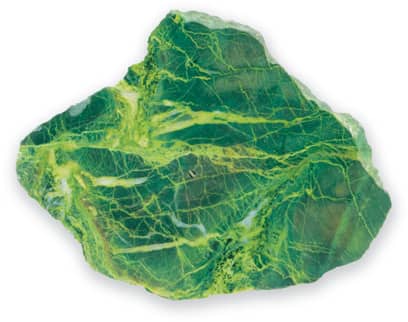
THE CRYSTAL
 Found worldwide, jasper refers to an opaque microcrystalline quartz, and comes in many color variations. Green jasper has been found in archeological sites of the mid-Neolithic period dating back to 3000 BCE. It is sometimes found in fissures in igneous rock, but mostly shows as veins or cracks in volcanic outcrops.
Found worldwide, jasper refers to an opaque microcrystalline quartz, and comes in many color variations. Green jasper has been found in archeological sites of the mid-Neolithic period dating back to 3000 BCE. It is sometimes found in fissures in igneous rock, but mostly shows as veins or cracks in volcanic outcrops.
LEGENDARY USES
Known since antiquity as “rain bringer,” green jasper has long been a sought-after stone, valued for its ability to protect, strengthen, and fertilize the Earth. The first-century Roman physician Galen wore a special jasper ring to reveal his healing power. The stone was carved in the shape of a man carrying a bundle of medicinal plants. He also declared that wearing a green jasper pendant would protect the lungs and stomach, as did the Egyptian king, Nechepsus, who wore a jasper encrusted belt around his belly.
ATTRIBUTES AND POWERS
These are stones of courage, wisdom, creativity, and harmony, dissolving fear, negativity, and obsessive thinking. Wearing green jasper helps to keep yourself in balance and instill harmony among those around you. Enabling you to recognize irrational fears as simply that, the stone promotes courage and honesty, and the ability to express and accept your faults, in order to move forward. It also brings acceptance of others' faults too and a non-judgmental attitude to life. Green jasper encourages self-control and responsibility for your life path, restoring harmony in all you do.
JET
APPEARANCE/COLOR: Black
CURRENT AVAILABILITY: Common
PHYSIOLOGICAL CORRESPONDENCE: Lymph system
PSYCHOLOGICAL CORRESPONDENCE: Stability, protection from self-doubt
ASSOCIATED CRYSTALS BY COLOR: Onyx, black obsidian
KEYWORDS: Balancing, home protector, removes negativity
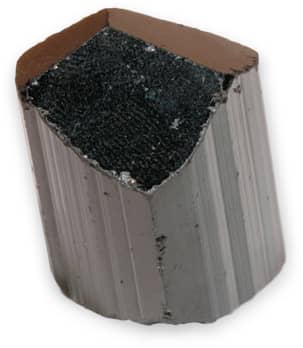
THE CRYSTAL
 Like amber, jet is not a true crystal, but is fossilized wood formed millions of years ago when trees were buried in sediment. Later geological erosion of the sedimentary layers revealed jet, also known as lignite, within rock and coal seams. It is found mostly in India, Europe, Russia, and the USA.
Like amber, jet is not a true crystal, but is fossilized wood formed millions of years ago when trees were buried in sediment. Later geological erosion of the sedimentary layers revealed jet, also known as lignite, within rock and coal seams. It is found mostly in India, Europe, Russia, and the USA.
LEGENDARY USES
Ornate pieces of carved jet have been found dating as far back as 1200 BCE in prehistoric burial mounds. The ancient Greeks believed that wearing jet would insure favor from the gods, while later medieval healers believed that burning jet around a patient would cure most illnesses. The allusion to bestowing the wearer with godly favor was assimilated into Christian superstition and in the Renaissance, jet was the popular component used to create rosary beads for monks. Native American peoples, such as the Pueblo Indians, buried their dead with pieces of jet, believing it would protect their souls in the afterlife.
ATTRIBUTES AND POWERS
Throughout history jet has been considered to be a stone of protection and was used to dispel fear, evil, and violence. Its powerful protection energies are said to shield us from evil influences and geopathic stress, as well as psychic negativity from other people. Jet is considered one of the most powerful absorbers of “negative energy,” reviving spirits and replacing worry with joyous thoughts. The stone also helps you to be mentally alert and to quickly find solutions to problems. Wearing or carrying polished jet enables you to take control of your life, and also attract all-round balance to the heart and home.
LAZULITE
APPEARANCE/COLOR: Dark indigo blue to sky blue
CURRENT AVAILABILITY: Rare, can be found in specialty stores
PHYSIOLOGICAL CORRESPONDENCE: Nervous system
PSYCHOLOGICAL CORRESPONDENCE: Self-esteem
ASSOCIATED CRYSTALS BY COLOR: Lazurite, sodalite
KEYWORDS: Focus, self-confidence, and emotional balance
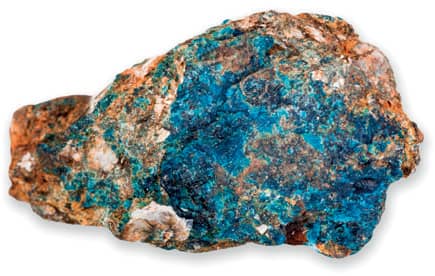
THE CRYSTAL
 A blue, phosphate mineral containing magnesium, iron, and aluminum phosphate, its name derives from the Persian word lazhward, meaning "heavenly blue." Not to be confused with lazurite, crystals of lazulite are small and usually embedded in a matrix of other rock. The finest specimens are found in the US state of Georgia, Austria, Italy, and the Yukon Territory, Canada.
A blue, phosphate mineral containing magnesium, iron, and aluminum phosphate, its name derives from the Persian word lazhward, meaning "heavenly blue." Not to be confused with lazurite, crystals of lazulite are small and usually embedded in a matrix of other rock. The finest specimens are found in the US state of Georgia, Austria, Italy, and the Yukon Territory, Canada.
LEGENDARY USES
Although there are no obvious legends concerning lazulite, it is still often confused with lazurite and lapis lazuli. With its deeper shades of ultramarine blue it is, like other blue stones, a symbol of the power of the night sky.
ATTRIBUTES AND POWERS
Lazulite is a stone that works on many levels. It begins by gently promoting a sense of spiritual well-being and inner harmony. It then enhances emotional balance and physical health, and connects all three to bring you a sense of self-confidence and empowerment. By boosting self-esteem and intuitive powers, lazulite assists in finding solutions to problems and is a useful ally in any form of negotiation. Because it enhances your focus and self-discipline, wearing the stone reduces stress and aligns you with what is needed in the moment, rather than being preoccupied with the past or the future.
MOONSTONE
APPEARANCE/COLOR: Clear, white, blueish-white
CURRENT AVAILABILITY: Widely available
PHYSIOLOGICAL CORRESPONDENCE: Reproductive system, pineal gland, skin, liver
PSYCHOLOGICAL CORRESPONDENCE: Emotional intelligence, empathy
ASSOCIATED CRYSTALS BY COLOR: Opal, clear spinel
KEYWORDS: Intuition, calmness, psychic ability
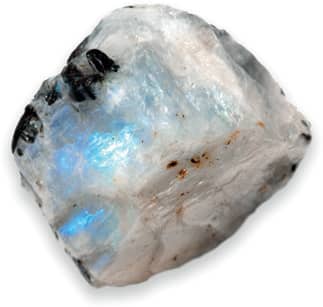
THE CRYSTAL
 Moonstone earned its name from its appearance. The stone has a kind of opalescent sheen, caused by light diffraction, that makes it seem to glow—like the full moon. This visual effect comes from its particular microstructure, a succession of fine layers of the rock feldspar.
Moonstone earned its name from its appearance. The stone has a kind of opalescent sheen, caused by light diffraction, that makes it seem to glow—like the full moon. This visual effect comes from its particular microstructure, a succession of fine layers of the rock feldspar.
LEGENDARY USES
Moonstones have always been thought to be linked to the power of the lunar cycle itself and so attuned to the rhythms of the oceans, too. The Romans believed that stone revealed an image of their moon goddess, Diana, and that wearing moonstone bestowed the owner with love, wisdom, prophecy, and second sight. This lovely translucent crystal has long been an amulet of protection for travelers and a gift between lovers to enhance passion.
ATTRIBUTES AND POWERS
The moon itself is a potent symbol of all things intuitive and feminine, the rhythms of nature, the sensitive, nurturing powers of all aspects of life. Moonstones bring inspiration, flashes of insight, and make you trust your intuition, so that you “see" from your “third eye" or sixth sense, rather than “react" from only your thoughts. Wearing this stone promotes clarity of mind and inner vision, and keeps you focused and balanced. White moonstone stimulates psychic perception, vision, and dream work. Generally, it is a stone that opens the mind to inspiration and attracts both spiritual and emotional harmony.
NUUMMITE
APPEARANCE/COLOR: Black
CURRENT AVAILABILITY: Rare, available from specialty stores
PHYSIOLOGICAL CORRESPONDENCE: Pancreas
PSYCHOLOGICAL CORRESPONDENCE: Self-empowerment
ASSOCIATED CRYSTALS BY COLOR: Jet, onyx
KEYWORDS: Magical well-being, connection to the magic within you
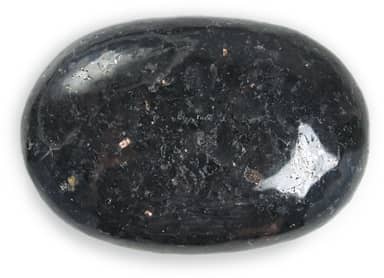
THE CRYSTAL
 This rare black stone was first collected in Greenland in 1810 by mineralogist K. L. Giesecke. Rediscovered in the 1980s, its name means “from Nuuk,” in reference to the Nuuk region of Greenland, the only place where it occurs. Formed more than three billion years ago, it is thought to be the oldest-known rock on Earth and is prized for its iridescent play of color due to the tiny flecks of minerals within.
This rare black stone was first collected in Greenland in 1810 by mineralogist K. L. Giesecke. Rediscovered in the 1980s, its name means “from Nuuk,” in reference to the Nuuk region of Greenland, the only place where it occurs. Formed more than three billion years ago, it is thought to be the oldest-known rock on Earth and is prized for its iridescent play of color due to the tiny flecks of minerals within.
LEGENDARY USES
Although little legendary information is available, because it is probably the oldest stone on Earth, it resonates with the earliest creation myths from ancient India and Mesopotamia when the Cosmos manifested from the Void. Used in magic spells and enchantments nuummite can similarly help you to manifest your invisible desires into reality. This is a stone for magical well-being and restoring balance holistically, as well as understanding the right use of power.
ATTRIBUTES AND POWERS
Unlocking the key to your own inner magic, nuummite is considered to be the stone to teach you true spiritual well-being. Known as the “sorcerer's stone” and worn as a talisman, it not only increases your own personal charisma, but enhances your clairvoyant or intuitive powers. Place a piece of nuummite beside you when working with divination tools to boost your ability to read the symbols and signs around you. The stone also deepens your connection to the natural world and the cosmos, relieving fear of the unknown and strengthening your contact with the spiritual realm. Offering spiritual protection, it enhances all forms of magical exploration and a feeling that you can create your own destiny and manifest your deepest desires.
ONYX (BLACK)
APPEARANCE/COLOR: Black
CURRENT AVAILABILITY: Common
PHYSIOLOGICAL CORRESPONDENCE: Bones
PSYCHOLOGICAL CORRESPONDENCE: Self-reliance, control
ASSOCIATED CRYSTALS BY COLOR: Jet, black obsidian
KEYWORDS: Holistic balance, protection in the home
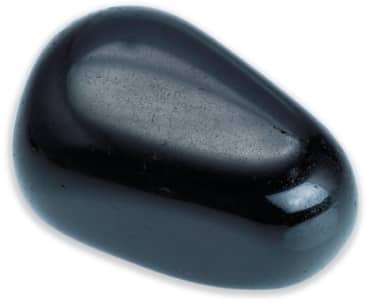
THE CRYSTAL
 Although onyx is a variety of chalcedony (see here), its banded, marble-like appearance more closely resembles an agate. Other onyx colors, such as red, or yellow, are far more strikingly marked, whereas black onyx usually has either indistinct bands of gray or wider bands of white.
Although onyx is a variety of chalcedony (see here), its banded, marble-like appearance more closely resembles an agate. Other onyx colors, such as red, or yellow, are far more strikingly marked, whereas black onyx usually has either indistinct bands of gray or wider bands of white.
LEGENDARY USES
Onyx was popular with the ancient Greeks and Romans and it was carved into jewelry and other decorative ornaments. The name is said to derive from the Greek word meaning “fingernail” or “claw,” due to the fact that the pink-banded variety of onyx resembled fingernails. In one legend, Cupid uses an arrowhead to cut the fingernails from the goddess Venus while she sleeps, leaving the clippings scattered in the sand. The Fates turned them into onyx stones so that although they were no longer immortal, they would never be destroyed.
ATTRIBUTES AND POWERS
A grounding and centering stone, onyx promotes stillness, balance, and strength and can help you concentrate while dissolving any restlessness. This is a powerful strengthening stone to help you with any learning process, and wearing black onyx instills greater self-confidence and determination. The stone brings balance to the body, harmony to the mind, and enhances intuition and instinctive power. Wearing the stone can help to reduce stress and alleviate fears and also stimulate the power of wise decision-making.
OBSIDIAN
APPEARANCE/COLOR: Black, brown, green, blue
CURRENT AVAILABILITY: Readily available
PHYSIOLOGICAL CORRESPONDENCE: Joints, digestive system
PSYCHOLOGICAL CORRESPONDENCE: Truth, power issues
ASSOCIATED CRYSTALS BY COLOR: Black tourmaline, onyx
KEYWORDS: Absorbs negativity, establishes a sense of self
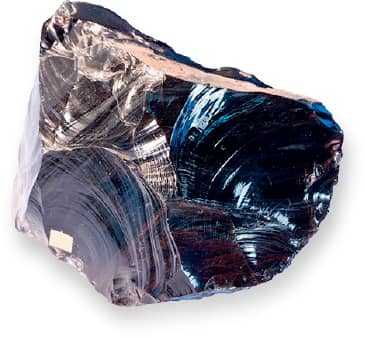
THE CRYSTAL
 Obsidian is formed from volcanic lava, which cooled too quickly for significant crystallization to occur. Varieties of obsidian, such as black, mahogany, apache tears, and rainbow obsidian, can all be used to equal effect, depending on the intensity of manifestation desired.
Obsidian is formed from volcanic lava, which cooled too quickly for significant crystallization to occur. Varieties of obsidian, such as black, mahogany, apache tears, and rainbow obsidian, can all be used to equal effect, depending on the intensity of manifestation desired.
LEGENDARY USES
The Greek writer Theophrastus told how ancient Greek magicians polished obsidian to make scrying mirrors—a way of seeing into the future. A Native American Apache legend tells of a group of Apache warriors who met their deaths falling from a high cliff during a 19th-century campaign against the military. When the tears of the mourning women fell to the ground, the Great Spirits were so saddened they turned their tears to stone. Ever after these stones were known as Apache tears. It is believed that whoever carries obsidian will never cry again, as too many tears have already been shed.
ATTRIBUTES AND POWERS
All forms of obsidian can be carried to absorb negative energies and instil harmony and self-confidence. For self-empowerment, black obsidian protects you, yet reveals deeper truths. As a protective stone, it provides personal direction and acceptance of what you truly need on your life journey. Apache tears and mahogony obsidian are gentler than the black variety, and these are recommended if you fear facing suppressed emotional issues. Black obsidian, particularly, brings perseverance and determination and promotes a genuine desire to work toward agreement with others.
PIETERSITE
APPEARANCE/COLOR: Mottled browns, blue-gray
CURRENT AVAILABILITY: Rare but available from specialty stores
PHYSIOLOGICAL CORRESPONDENCE: Pinal and pituitary gland
PSYCHOLOGICAL CORRESPONDENCE: Truth
ASSOCIATED CRYSTALS BY COLOR: Idocrase, apatite
KEYWORDS: Trusting instincts or one's inner self
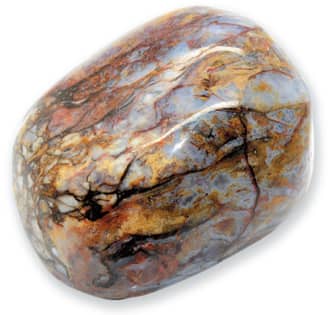
THE CRYSTAL
 Due to its swirling inclusions of golden crocidolite (which also gives tiger's eye its “chatoyancy” effect), pietersite's main body colour can range from deep brown—usually found in stones from Henan Province, China—to blue-gray when originating from Namibia, where it was first described in 1962 by mineral dealer Sid Pieters.
Due to its swirling inclusions of golden crocidolite (which also gives tiger's eye its “chatoyancy” effect), pietersite's main body colour can range from deep brown—usually found in stones from Henan Province, China—to blue-gray when originating from Namibia, where it was first described in 1962 by mineral dealer Sid Pieters.
LEGENDARY USES
Since pietersite is a relatively recent discovery, little legendary history surrounds the stone. It is also known as the “tempest stone,” perhaps, some healers say, because of its at-times stormy appearance, and the fact that it is also thought to possess a highly charged vibrational energy that aligns to stormy weather. The stone is said to protect you from bad weather if carried when driving or traveling, and to protect home and property from storms if left in a grid at each point of the compass around the home.
ATTRIBUTES AND POWERS
Apart from pietersite’s protective power against bad weather, holding, wearing, or carrying the stone enhances focus and personal will. It is also a stone of vision, enabling you to “see” long term what you truly intend to manifest, and how this can aid your well-being. Promoting an instinctive or inner sense of what's right for you, pietersite dissolves others' expectations or opinions so you can see the truth of who you are. Acting as a shield against the adverse effects of technology, it is a superb proactive stone against geopathic stress, electromagnetic energy from phones, computers, electricity cables, underground trains, cellphone masts, and similar.
PREHNITE
APPEARANCE/COLOR: Apple green, yellow-green
CURRENT AVAILABILITY: Available from specialty stores
PHYSIOLOGICAL CORRESPONDENCE: Pancreas and insulin regulation
PSYCHOLOGICAL CORRESPONDENCE: Letting go, astute awareness
ASSOCIATED CRYSTALS BY COLOR: Jade, serpentine
KEYWORDS: Protective grid stone, harmony in the environment
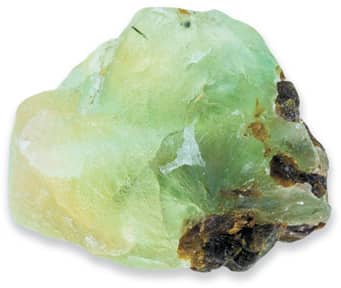
THE CRYSTAL
 Composed of aluminum, calcium, and silicon, prehnite is brittle with an uneven surface and a vitreous to pearly luster. It is found in the veins of volcanic rock rich in magnesium and iron. The most important sources around the world are Namibia, South Africa, Australia, China, Scotland, and France.
Composed of aluminum, calcium, and silicon, prehnite is brittle with an uneven surface and a vitreous to pearly luster. It is found in the veins of volcanic rock rich in magnesium and iron. The most important sources around the world are Namibia, South Africa, Australia, China, Scotland, and France.
LEGENDARY USES
Named after Dutch colonel and mineralogist H. Von Prehn, who discovered it in Cradock, Eastern Cape Province, South Africa in 1788, early traders nicknamed the gemstone “Cape Emerald” in hopes of exploiting its green color. Prehnite was originally classified as a zeolite, due to the fact that it usually forms in the same areas and under similar conditions as zeolite. There are currently no known legends, but New Age healers and crystal experts hold that it connects you directly to divine energy, and that it can promote psychic skill and even prophetic powers.
ATTRIBUTES AND POWERS
A powerfully protective stone, prehnite stimulates the life force and vitalizes the body. Wearing or carrying the stone enhances deep self-knowledge, and encourages analytical thinking. This is a stone that opens you up to your true potentials and talents, and placing it in a grid around your home will help to manifest those potentials. As a cleansing stone, prehnite motivates you to declutter your home, and also to let go of the past and start afresh.
SAPPHIRE (CLEAR)
APPEARANCE/COLOR: White or clear
CURRENT AVAILABILITY: Naturally clear rare; industrialized common
PHYSIOLOGICAL CORRESPONDENCE: Blood
PSYCHOLOGICAL CORRESPONDENCE: Charisma, strength, tolerance
ASSOCIATED CRYSTALS BY COLOR: Diamond, clear quartz
KEYWORDS: Integrity, truth, fairness
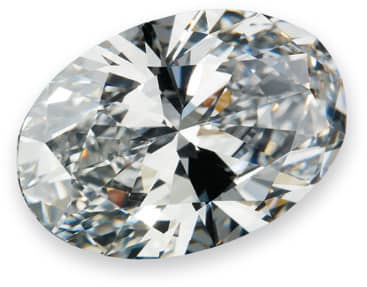
THE CRYSTAL
 Sapphire is a variety of corundum, an aluminum oxide mineral. When produced industrially, clear sapphire is known as leuco-sapphire. Totally natural colorless sapphire is rare, as there is usually an irregular hint of blue or yellow within all sapphire stones. Because of its extreme hardness and appearance, leuco-sapphire is often used as a diamond substitute.
Sapphire is a variety of corundum, an aluminum oxide mineral. When produced industrially, clear sapphire is known as leuco-sapphire. Totally natural colorless sapphire is rare, as there is usually an irregular hint of blue or yellow within all sapphire stones. Because of its extreme hardness and appearance, leuco-sapphire is often used as a diamond substitute.
LEGENDARY USES
The name corundum is of Indian origin, derived from the Sanskrit word korund, and used to describe opaque massive gems. With the exception of red corundum, which is ruby, all other colors of corundum are sapphires. Babylonian magicians used clear sapphires to enhance and direct their magical powers. Medieval alchemists and astrologers associated this sapphire with the element of air, and astrologers in India believed it was a portal to the heavenly realms. The Greeks identified sapphires with Apollo, and the stone was worn by the Pythia, the high priestess at Apollo's temple at Delphi, when speaking the oracles sent to her by the god.
ATTRIBUTES AND POWERS
Sapphire endows the wearer with wisdom and spiritual strength. The stone enhances clarity of thought and opens you to the deeper powers of your imagination as well as the ability to focus with logic and objectivity. Promoting a realization of who you really are, it inspires you to live with integrity and keep true to your own beliefs when faced with difficult choices or circumstances. Wearing the stone enhances the qualities of fairness, objectivity, and freedom from unnecessary need. It also enables you to truly know your hidden talents and potential for manifesting your life purpose.
SELENITE
APPEARANCE/COLOR: Clear
CURRENT AVAILABILITY: Common
PHYSIOLOGICAL CORRESPONDENCE: Spinal column
PSYCHOLOGICAL CORRESPONDENCE: Clarity, understanding
ASSOCIATED CRYSTALS BY COLOR: Clear quartz, clear topaz
KEYWORDS: Peaceful atmosphere, peaceful mind
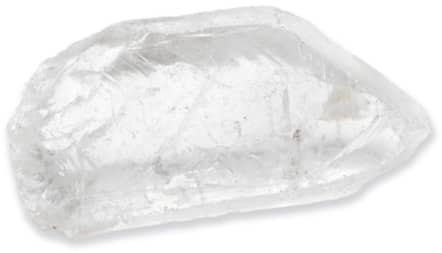
THE CRYSTAL
 Calcium sulfate, better known as gypsum, a non-metallic mineral used to make plaster, is also found as large, clear, glass-like crystals known as selenite. Forming in sedimentary rock where seawater or underground water has evaporated, the stone is very soft and easily scratched.
Calcium sulfate, better known as gypsum, a non-metallic mineral used to make plaster, is also found as large, clear, glass-like crystals known as selenite. Forming in sedimentary rock where seawater or underground water has evaporated, the stone is very soft and easily scratched.
LEGENDARY USES
Selenite originates from an ancient Greek word meaning “stone of the moon.” The Greek moon goddess Selene fell in love with the mortal Endymion, but could only make love to him while he slept. So she left a “moon-stone” beside him so that when he woke he would remember her. Ancient astrologers and seers believed that that the power of certain transparent crystals, such as selenite and clear quartz, waxed and waned with the lunar cycle. In ancient Rome it was believed that if you kept a piece of selenite in a charm pouch it would insure fidelity “until the seas run dry.” Another source describes how a tree's fruit will flourish if a stone is hung in its branches.
ATTRIBUTES AND POWERS
Translucent selenite brings clarity of mind, opening the crown and higher chakras while accessing higher guidance. It stills the mind, enables you to find peace within and also peace without. It is perfect for forming a harmony-invoking grid around the home. Place one piece at each of the compass points around your home, north, south, east, and west, and similarly, create a grid on your altar with the same layout to amplify its protective and calming power. Alternatively, place a large piece in a window ledge or by the front door to enhance peace and tranquility among family members.
SERPENTINE
APPEARANCE/COLOR: Green, red, brown-red, black-green
CURRENT AVAILABILITY: Widely available
PHYSIOLOGICAL CORRESPONDENCE: Pancreas and insulin regulation
PSYCHOLOGICAL CORRESPONDENCE: Self-control, decision-making
ASSOCIATED CRYSTALS BY COLOR: Bloodstone, brown aragonite
KEYWORDS: All-round well-being, self-reliance
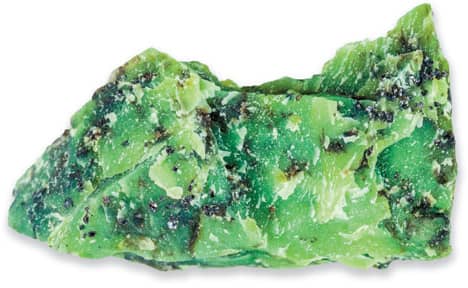
THE CRYSTAL
 Serpentine stones are opaque to translucent and can have a mottled appearance resembling a snake’s skin. The name refers to a group of predominantly green minerals that occur in masses of small, intergrown crystals, with two basic structures: antigorite (leafy serpentine) and chrysotile (fibrous serpentine).
Serpentine stones are opaque to translucent and can have a mottled appearance resembling a snake’s skin. The name refers to a group of predominantly green minerals that occur in masses of small, intergrown crystals, with two basic structures: antigorite (leafy serpentine) and chrysotile (fibrous serpentine).
LEGENDARY USES
Serpentine was used in ancient Greece and Rome as a talisman to protect against snake or scorpion bites, poison, curses, and evil. To protect high-ranking nobles or royalty against poisoners, drinking vessels were made of serpentine because it was believed that the goblet or cup would shatter to pieces if it came into contact with poison. The ancient Meso-American peoples believed that wearing serpentine would bring warriors unrivaled energy, as well as act as a protector of the soul against invisible powers.
ATTRIBUTES AND POWERS
Serpentine enables you to take control of your life rather than feel at the mercy of fate. It promotes self-empowerment and confidence in making decisions and allows you to make a choice without fear of the consequences. Like the cunning of a snake, the stone bestows you with mental wit and guile, and psychologically brings you a sense of inner harmony and outer peace. As a protective stone, serpentine is an all-round stone for harmony and self-reliance, and is said to increase the longevity of the wearer.
SODALITE
APPEARANCE/COLOR: Blue, mottled blue, and white
CURRENT AVAILABILITY: Widely available
PHYSIOLOGICAL CORRESPONDENCE: Larynx, lymph glands
PSYCHOLOGICAL CORRESPONDENCE: Self-esteem, self-acceptance
ASSOCIATED CRYSTALS BY COLOR: Tanzanite, chrysocolla
KEYWORDS: Peace, calm, harmonious home
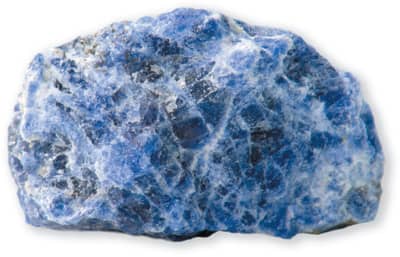
THE CRYSTAL
 Sodalite gets its name from the sodium content found within this mineral. Although occurring in many shades of blue, it is often mistaken for lapis lazuli. Sodalite rarely contains the pyrite or gold-colored specks that give lapis its sparkle.
Sodalite gets its name from the sodium content found within this mineral. Although occurring in many shades of blue, it is often mistaken for lapis lazuli. Sodalite rarely contains the pyrite or gold-colored specks that give lapis its sparkle.
LEGENDARY USES
This rich blue mineral was first found in Greenland in 1806. It only gained recognition as an ornamental stone after large deposits of sodalite were discovered in Ontario in the 1890s and, coinciding with a visit to Canada by Princess Margaret of England, it became nicknamed “Princess Blue,” when the princess chose the stone for the interior decoration of her new home, Marlborough House. Sodalite has been known as the stone of creativity, and artists have used it in frescos.
ATTRIBUTES AND POWERS
By dissolving mental confusion, the stone enables you to think objectively about your future, and enhance emotional honesty. Amplifying intelligence and learning, sodalite also promotes inner peace and a calm temperament. Placing a piece in every room of the home enables its peace-enhancing properties to permanently flow around the environment. Keep a stone near computers and microwave ovens to reduce electromagnetic smog. Renowned for being a brilliant “psychic sponge,” sodalite removes any negative energy left by past inhabitants, simultaneously promoting trust and acceptance between family members.
SULFUR
APPEARANCE/COLOR: Yellow
CURRENT AVAILABILITY: Available from specialty stores
PHYSIOLOGICAL CORRESPONDENCE: Skin
PSYCHOLOGICAL CORRESPONDENCE: Instills self-reliance
ASSOCIATED CRYSTALS BY COLOR: Citrine, septarian
KEYWORDS: Vitality, creativity, motivation
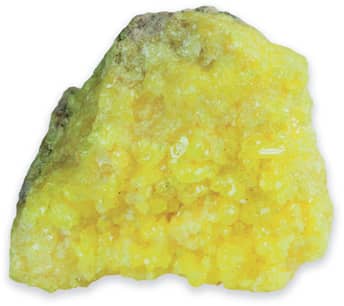
THE CRYSTAL
 Bright yellow sulfur was once known as brimstone and is found near hot springs and volcanic regions throughout the world. For metaphysical use, choose polished and cut crystals as sulfur dust is toxic.
Bright yellow sulfur was once known as brimstone and is found near hot springs and volcanic regions throughout the world. For metaphysical use, choose polished and cut crystals as sulfur dust is toxic.
LEGENDARY USES
Sulfur, also written as sulphur, is referred to in the Torah, the central reference work of the Jewish religious tradition. English translations referred to burning sulfur as brimstone. This inspired the “fire-and-brimstone” sermons, in which priests reminded their flock of their fate of eternal damnation if they did not repent their sins. In the Old Testament, Hell was thought to smell of sulfur, perhaps due to its association with volcanic activity. The Roman historian Pliny the Elder noted that sulfur was used for fumigation and bleaching fabric, and the best-known source in the ancient world was the Greek island of Melos.
ATTRIBUTES AND POWERS
In the crystal healing world, sulfur is a stone of vitality and energy. Promoting protection and purifying the mind, it removes negative thoughts, banishes stubborn or willful attitudes, and instills a new perception and acceptance of other people's attitudes. Grounding and stabilizing, it promotes general well-being and its bright yellow color brings a vitality and joie de vivre to your everyday life. Placed in the south area of your home, it absorbs negativity of any kind and enables you to get motivated and creative with your goals.
TOURMALINE, BLUE
APPEARANCE/COLOR: Blue
CURRENT AVAILABILITY: Available from specialty stores
PHYSIOLOGICAL CORRESPONDENCE: Skin, immune system
PSYCHOLOGICAL CORRESPONDENCE: Positive attitude
ASSOCIATED CRYSTALS BY COLOR: Blue sapphire, lapis lazuli
KEYWORDS: Sense of purpose, luck and empowerment
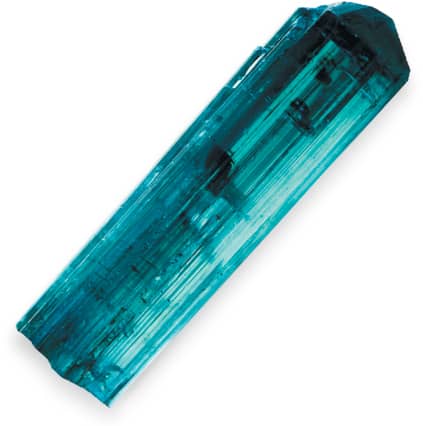
THE CRYSTAL
 In common with all tourmalines, coveted blue tourmaline has a trigonal crystal structure. It is much rarer than the other tourmalines in this, the most colorful of all gemstone groups, and forms in shades of light to dark blue. Brazil is the major source of most blue tourmaline, including the much-prized turquoise variety known as the Paraiba stone.
In common with all tourmalines, coveted blue tourmaline has a trigonal crystal structure. It is much rarer than the other tourmalines in this, the most colorful of all gemstone groups, and forms in shades of light to dark blue. Brazil is the major source of most blue tourmaline, including the much-prized turquoise variety known as the Paraiba stone.
LEGENDARY USES
In ancient indigenous cultures including tribal peoples of Africa and Australia, tourmaline was thought to bring healing power to the user and provide protection from all dangers. Its popularity as a gemstone began in 1876, when mineralogist and collector George F. Kunz sold a tourmaline to Tiffany & Co. in New York, and the gem’s desirability spread. More recently, with its versatile energy properties, it has become a favorite stone for crystal healers.
ATTRIBUTES AND POWERS
Blue tourmaline promotes clear and honest communication, and gives you the courage to speak from the heart. Wearing the stone encourages an open mind and tolerance for others’ differences. Placing a grid of stones in your home will bring harmony to the family and balance the environment. Use the paler, turquoise-colored crystals to enhance any space that you use for relaxing. With its power to manifest a happy attitude and positive sense of self, blue tourmaline allows you to see how to let your life unfold and flow to restore well-being.
CRYSTALS for LOVE
We all want to manifest in our life that enigmatic, quality love. Some of us are lucky enough to feel blessed with a loving marriage, or a long-term commitment, yet we may feel that we are misunderstood, or not “loved” for who we truly are; we may be unable to communicate our feelings or fear hearing words we don't wish to hear from a current admirer. We may want love to become a reality, rather than a possibility, as is often the issue with long-distance relationships. If we love someone but have no physical contact, our imagination works overtime, wondering why they haven't texted us ten times a day and what they might be up to.
Using crystals helps you to manifest the truth of the relationship and to see it for what it really is. Working with these stones can also “make a relationship a physical reality” if you truly believe that you are going to be with that person. Some of us want only eternal romance and the magic of passionate affairs or the “perfect” lover. Idealists abound as do realists, but what almost all of us seek is to create a unique relationship with someone, where we are free from fears, doubts, and jealous imaginings. It's a hard love road we travel along, but the following stones can help you manifest your true desires. But before you focus your intention, first ask yourself two questions: What does love really mean for you, and what kind of love relationship do you truly seek?

AMAZONITE
APPEARANCE/COLOR: Blue, turquoise, green with light veins
CURRENT AVAILABILITY: Widely available
PHYSIOLOGICAL CORRESPONDENCE: Nervous system
PSYCHOLOGICAL CORRESPONDENCE: Balanced judgment
ASSOCIATED CRYSTALS BY COLOR: Turquoise, blue lace agate
KEYWORDS: Loving communication
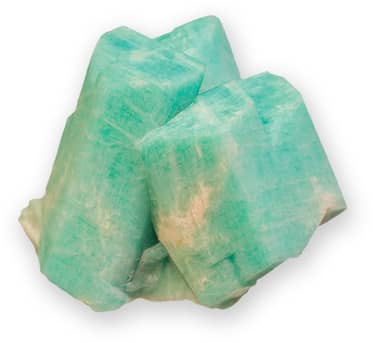
THE CRYSTAL
 Amazonite, also known as amazon stone, is a green to blue-green variety of microcline, a feldspar mineral. It ranges in hue from bright green to paler shades of turquoise, often with white, yellow, or gold-colored veins, and it can also be translucent or opaque.
Amazonite, also known as amazon stone, is a green to blue-green variety of microcline, a feldspar mineral. It ranges in hue from bright green to paler shades of turquoise, often with white, yellow, or gold-colored veins, and it can also be translucent or opaque.
LEGENDARY USES
In ancient India, Egypt, and Mesopotamia amazonite was used as a decorative material for buildings and was a popular amulet stone. An amazonite scarab ring was found among Pharaoh Tutankhamun’s treasures, and in biblical tradition, the stone was believed to be the third stone in the breastplate of the High Priest, Aaron. One legend says it gets its name from adorning the shields of the Amazonians, a formidable tribe of Bronze Age female warriors. Some stories claim the more ferocious women had one breast removed to be more effective in their archery skills, and rubbed their wounds with a polished amazonite to avoid infection.
ATTRIBUTES AND POWERS
A stone of courage, Amazonite allows you to discover your own integrity, and to move beyond fear of judgment or confrontation with others. Promoting freedom of expression, it can help you to set strong and clear boundaries in love relationships. Wearing the stone revitalizes the heart and throat chakras and invokes loving communication on all levels. Stirring compassion for others, the stone enables you to see both sides to any dilemma, and to accept differences of opinion without taking things personally. With its power to raise self-esteem, amazonite enhances your ability to communicate your feelings more effectively.
BRONZITE
APPEARANCE/COLOR: Earthy brown
CURRENT AVAILABILITY: Common
PHYSIOLOGICAL CORRESPONDENCE: Blood, circulatory system
PSYCHOLOGICAL CORRESPONDENCE: Compassion
ASSOCIATED CRYSTALS BY COLOR: Smoky quartz, tiger's eye
KEYWORDS: Non-judgmental love and acceptance
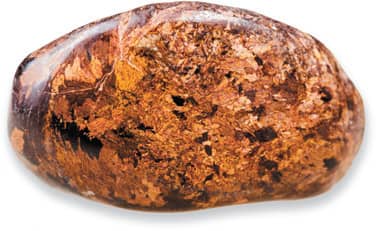
THE CRYSTAL
 Bronzite is composed of enstatite and hypersthene, a mix of magnesium and magnesium iron silicate. With its inclusions of hematite and geothetite, bronzite radiates sparkling bronze flashes named “schiller.” Polishing the stone exaggerates its metallic luster.
Bronzite is composed of enstatite and hypersthene, a mix of magnesium and magnesium iron silicate. With its inclusions of hematite and geothetite, bronzite radiates sparkling bronze flashes named “schiller.” Polishing the stone exaggerates its metallic luster.
LEGENDARY USES
Bronzite's high iron content was sacred to the ancient Vedic Indians who believed it was a gift from the gods. Similarly, in Buddhist Tibet, ritual objects were usually made of iron, because they were thought to have been tempered by the celestial gods. Many of the vajras—ritual weapons representing the thunderbolt and the diamond—were placed with the statue of a god, and were forged from meteorite iron, known to the ancient priests as “sky iron.” The high-altitude, desolate landscape of Tibet is littered with these meteorite fragments.
ATTRIBUTES AND POWERS
Although bronzite is often used to protect against geopathic stress, it is also a great stone to attract the right kind of lover or partner. Increasing self-esteem and self-worth, wearing bronzite means you can go out into the world and attract the same goodness back to you. Known as a “stone of courtesy,” bronzite promotes non-judgmental attitude toward the people you meet. It helps you to retain your own power, without trying to force your opinions on others, and helps you to see that other people may have a different perspective on life from you. When you wear this stone, you can successfully attract potential partners to you without either of you resorting to power games.
CHRYSOCOLLA
APPEARANCE/COLOR: Green, turquoise, blue
CURRENT AVAILABILITY: Common
PHYSIOLOGICAL CORRESPONDENCE: Lungs
PSYCHOLOGICAL CORRESPONDENCE: Heals heartbreak
ASSOCIATED CRYSTALS BY COLOR: Turquoise, blue sapphire
KEYWORDS: Enhances and attracts compassion, forgiveness
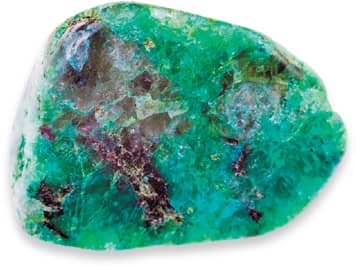
THE CRYSTAL
 The name of this stone is believed to come from the Greek words chrysos, gold, and kolla, glue, referring to its use to solder gold. Often found in association with malachite and azurite, chrysocolla is a copper phyllosilicate mineral, and is found in Russia, Chile, Mexico, and Arizona.
The name of this stone is believed to come from the Greek words chrysos, gold, and kolla, glue, referring to its use to solder gold. Often found in association with malachite and azurite, chrysocolla is a copper phyllosilicate mineral, and is found in Russia, Chile, Mexico, and Arizona.
LEGENDARY USES
In ancient Egypt, carrying the stone was thought to protect the mind and body from curses and evil thoughts, and so was worn by tradesmen and pharaohs alike in all important negotiations. As a stone of wise council and peace, the Native American shamans placed the stone at the center of a medicine wheel to help align with the forces of nature and the spirit world to insure good harvests.
ATTRIBUTES AND POWERS
If you need a stone to help you get over a break-up, or to help you forgive and be at peace with yourself and others, this is the stone for you. Not only does it “glue” back together your own broken feelings, making you feel whole again, but enhances any new emotional bonds. Chrysocolla encourages us to share our insights, and also to know the value of when to express one's feelings and when to stay silent. We can, after all, speak and say nothing, or remain silent and speak volumes. This stone’s soothing energy dispels highly charged emotional situations, angry words, or bitter disputes, and enables you to manifest your feelings without fear of being made a fool.
GARNET
APPEARANCE/COLOR: Deep red
CURRENT AVAILABILITY: Common
PHYSIOLOGICAL CORRESPONDENCE: Sexual organs
PSYCHOLOGICAL CORRESPONDENCE: Physical love
ASSOCIATED CRYSTALS BY COLOR: Ruby, red spinel
KEYWORDS: Passion, bliss, sexual excitement
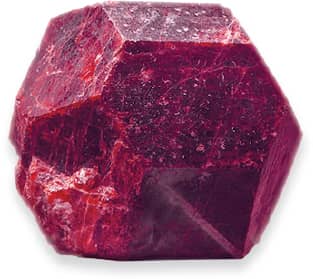
THE CRYSTAL
 The word “garnet” is derived from the Latin name for the pomegranate—granatum—and the granular varieties of garnet resemble the seeds of that fruit. Also known as “carbuncles,” meaning coal-fire, red garnets are the ultimate stone to stir love in another's heart.
The word “garnet” is derived from the Latin name for the pomegranate—granatum—and the granular varieties of garnet resemble the seeds of that fruit. Also known as “carbuncles,” meaning coal-fire, red garnets are the ultimate stone to stir love in another's heart.
LEGENDARY USES
The fiery-red carbuncle is at the heart of many ancient legends, including how it was suspended in Noah's Ark to diffuse light. The Greeks called the carbuncle the “lamp stone” and it was believed to give one the power to see in the dark if worn as a pendant. Throughout the medieval period, low libido and/or sexual disorders were thought to be relieved by the application of garnet directly to the genital organs. The 17th-century French Princess Palatine discovered her husband, the brother of King Louis XIV, applying garnets to his body in this way. He asked her not to reveal this to anyone; instead she told the whole court and wrote about it in her famous letters.
ATTRIBUTES AND POWERS
Garnet is the stone of sensuality, sexuality, and passion. With the incredible power to produce intense feelings of desire in an admirer, garnet revitalizes feelings, promotes self-esteem, and controls anger or jealousy. Several varieties of garnet have specific powers, including the most famous one, pyrope garnet, which is a mesmerizing stone, described as “living fire.” As a stone of inspiration, when worn or carried, garnet bestows you with vitality, charisma, and the ability to increase your popularity and draw love to you. Almandine garnet is a talisman of protection, but also a stone of physical love, stimulating the sex drive, and inspiring love and devotion.
GOSHENITE
APPEARANCE/COLOR: Colorless
CURRENT AVAILABILITY: Common
PHYSIOLOGICAL CORRESPONDENCE: Mental processes
PSYCHOLOGICAL CORRESPONDENCE: Clarity, honesty
ASSOCIATED CRYSTALS BY COLOR: Selenite, clear quartz crystal
KEYWORDS: Fidelity in love
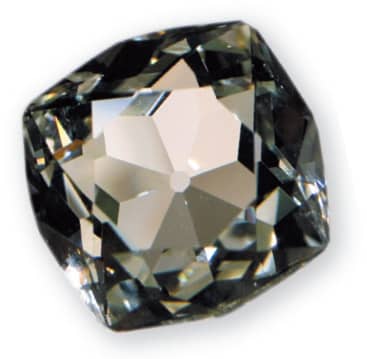
THE CRYSTAL
 Named after significant deposits were discovered in Goshen, Massachusetts, the stone is an aluminum beryllium silicate mineral. It forms in prismatic or vertically striated crystals, sometimes terminated by small pyramidal faces. Goshenite is transparent to translucent, with a vitreous luster.
Named after significant deposits were discovered in Goshen, Massachusetts, the stone is an aluminum beryllium silicate mineral. It forms in prismatic or vertically striated crystals, sometimes terminated by small pyramidal faces. Goshenite is transparent to translucent, with a vitreous luster.
LEGENDARY USES
Beryl crystals were favored for scrying and crystal-gazing by ancient Greek and Roman seers and magicians. The favorite shade used by ancient seers was the pale blue aquamarine, but the most transparent were better for seeing into the future, such as clear quartz (see here). These spheres of crystal were supposedly under the influence of the moon, and similarly the moon exerted its power when used by medieval sorcerers for love spells. When the moon waxed, goshenite had more power, thus attracting love, and when the moon waned, the power lessened and so love might be withheld.
ATTRIBUTES AND POWERS
Colorless goshenite is a feminine crystal of the moon and associated with motherhood. Wearing it enhances your ability to take a clear and honest look at what you want in a love relationship, and also enables you to see the sincerity of others. It promotes truthfulness above all, and encourages fidelity in relationships, honoring loyalty and respect, perseverance, and open-heartedness. You can also work with the stone to promote creative thinking, originality, and artistic expression. An excellent stone for stabilizing relationships, it bestows the wearer with a truly loving energy.
KUNZITE
APPEARANCE/COLOR: Pink, light violet, lilac, yellow
CURRENT AVAILABILITY: Once rare, available in specialty stores
PHYSIOLOGICAL CORRESPONDENCE: Heart, circulation
PSYCHOLOGICAL CORRESPONDENCE: Self-expression
ASSOCIATED CRYSTALS BY COLOR: Pink tourmaline, blue lace agate
KEYWORDS: Unconditional love
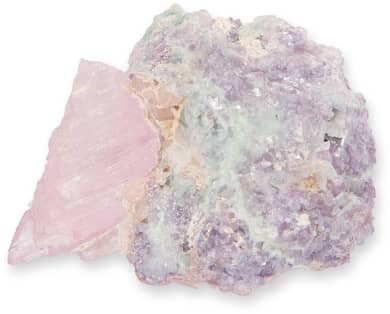
THE CRYSTAL
 Found predominantly in Russia, Brazil, the USA, and Madagascar, the stone was named for the mineralogist George F. Kunz, who first described the stone in 1902. Kunzite is a pink to violet variety of the silicate mineral spodumene. It has a glassy transparency and forms in flattened prismatic crystals with vertical striations.
Found predominantly in Russia, Brazil, the USA, and Madagascar, the stone was named for the mineralogist George F. Kunz, who first described the stone in 1902. Kunzite is a pink to violet variety of the silicate mineral spodumene. It has a glassy transparency and forms in flattened prismatic crystals with vertical striations.
LEGENDARY USES
As kunzite is a relatively recent find, there are no available legends. But it is a truly important stone for manifesting love, with many attributes. Kunzite opens the heart to all the energies of love—love of self, of others, of humanity, plants, animals, the Earth and everything it contains. By embracing all other types of love, you can connect to the essence of the universal energy in everything. The stone's soothing color removes anger or resentment, and can aid deep reflection.
ATTRIBUTES AND POWERS
For manifesting new romance and unconditional love, the pink and lilac colors are the most powerful. To attract new love romance or any kind of new relationships, wear or carry pink kunzite. It boosts your sensuality, and can also help overcome resentment or a feeling of loss in any relationship break-up. The stone enhances your charisma and attracts romance to you, especially if unconditional love is what you seek right now. Its high vibrational energy encourages letting go of fears and sorrows that prevent you from moving on, and for accepting the here and now. Kunite enhances free expression of feelings, healing the mind and heart, and allows you to be receptive to new gifts and opportunities in love.
KYANITE
APPEARANCE/COLOR: Blue (also pink and gray)
CURRENT AVAILABILITY: Widely available
PHYSIOLOGICAL CORRESPONDENCE: Thyroid, adrenal glands, urogenital system
PSYCHOLOGICAL CORRESPONDENCE: Insight, clarity of thought, speaking the truth
ASSOCIATED CRYSTALS BY COLOR: Blue quartz, blue moonstone
KEYWORDS: Communication in love, release from illusions
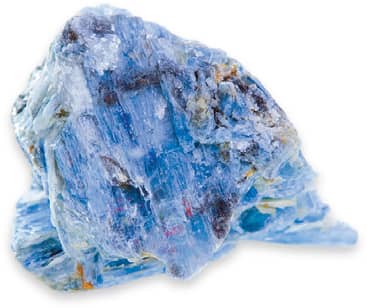
THE CRYSTAL
 Kyanite derives from the Greek word kyanos, meaning "deep blue," and was once commonly called disthene, meaning "two strengths.” The stone has a dual hardness depending on whether it is cut parallel to its long axis (softer) or perpendicular to it (harder). Its striated structure is formed of aluminum silicate.
Kyanite derives from the Greek word kyanos, meaning "deep blue," and was once commonly called disthene, meaning "two strengths.” The stone has a dual hardness depending on whether it is cut parallel to its long axis (softer) or perpendicular to it (harder). Its striated structure is formed of aluminum silicate.
LEGENDARY USES
Kyanite is often mistaken for sapphire. One apocryphal story tells of how the Sita Devi of Kapurthala, also known as Princess Karam, one of the most glamorous women of the mid-20th century, was given a necklace of apparently rare sapphires to add to her growing treasury of jewels. One day she dropped the necklace down a marble staircase and many of the stones shattered, proving they were not sapphires but highly brittle kyanite stones which had been badly mounted in their cabochons.
ATTRIBUTES AND POWERS
Associated with the throat chakra, kyanite is excellent for communication on all levels. This extraordinary crystal also enhances telepathic and psychic abilities, providing a link for transmitting or receiving loving, healing energy. When you wear or carry this stone, any sense of external fate becomes mere illusion, and you begin to realize that you create your own destiny. As a love stone, kyanite enables you to make decisions without feeling you need to compromise, to see the truth of any relationship, and sometimes even glimpse its outcome. Most importantly, it promotes clear communication and a deeper or, unspoken, connection with the one you love.
LAPIS LAZULI
APPEARANCE/COLOR: Rich, deep blue with gold flecks
CURRENT AVAILABILITY: Widely obtained, but the more gold flecks the more expensive
PHYSIOLOGICAL CORRESPONDENCE: Immune system
PSYCHOLOGICAL CORRESPONDENCE: Self-expression, endurance
ASSOCIATED CRYSTALS BY COLOR: Chrysocolla, blue tourmaline
KEYWORDS: Bonding, accepting others and self for who you/they are
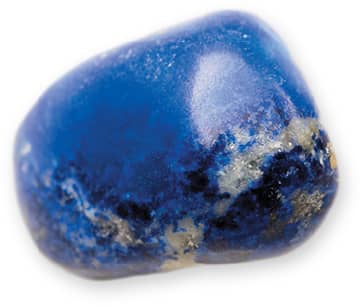
THE CRYSTAL
 The name of this stone comes from the Latin word for stone, lapis, and the ancient Persian word for blue, lazhward. It is rock formed by a combination of minerals, mostly lazurite, sodalite, and calcite, with gold flecks of pyrite. Lower-grade lapis lazuli is lighter blue with more white than gold flecks, and is sometimes called denim lapis.
The name of this stone comes from the Latin word for stone, lapis, and the ancient Persian word for blue, lazhward. It is rock formed by a combination of minerals, mostly lazurite, sodalite, and calcite, with gold flecks of pyrite. Lower-grade lapis lazuli is lighter blue with more white than gold flecks, and is sometimes called denim lapis.
LEGENDARY USES
Until the 19th century, ground lapis lazuli was the source of the painter’s finest deep-blue pigment, known as ultramarine. It was very costly, and was often used by Renaissance painters to depict their subject—for example, the flowing robes of the Virgin Mary—or the sea and sky. When lapis was first introduced in Europe, it was called ultramarinum, meaning “beyond the sea.” In ancient pre-Columbian America, the stone was a symbol of the starry night, and in ancient Persia it was used for protection against the evil eye. Similarly, medieval European magicians and astrologers believed wearing lapis lazuli, which symbolized the heavens, would protect against dark powers and attract the favor of the “daimons” of light and wisdom.
ATTRIBUTES AND POWERS
A stone of truth, lapis lazuli is worn for all forms of loving communication and to insure long-term bonds. Bringing harmonious energy to lovers, it also encourages objectivity, clarity, creative thinking, and compromise. Lapis lazuli is associated with Jupiter, amplifying wisdom and leadership qualities. It can also help to put an end to marital disputes, promoting solidarity and agreement. Lapis lazuli promotes self-awareness, and for standing up for oneself or taking charge of one’s life. To manifest solid, long-lasting bonds, wear a lapis lazuli ring. Its energy instills trust and emotional harmony by dissolving self-doubts, defensive reactions, and emotional game-playing.
MAGNETITE
APPEARANCE/COLOR: Black, browny-gray
CURRENT AVAILABILITY: Common
PHYSIOLOGICAL CORRESPONDENCE: Blood, circulation
PSYCHOLOGICAL CORRESPONDENCE: Tenacity, endurance
ASSOCIATED CRYSTALS BY COLOR: Tektite, brown tourmaline
KEYWORDS: A magnet for love
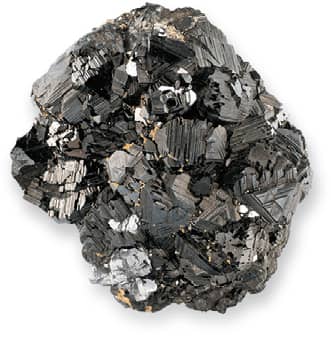
THE CRYSTAL
 Magnetite is a very common iron oxide mineral that is found in igneous, metamorphic, and sedimentary rocks. It is the most commonly mined ore of iron. This stone is common and occurs throughout the world, but most impressively in Mauritania, West Africa, where magnetite forms an entire mountain with a magnetic field so powerful that no compass works.
Magnetite is a very common iron oxide mineral that is found in igneous, metamorphic, and sedimentary rocks. It is the most commonly mined ore of iron. This stone is common and occurs throughout the world, but most impressively in Mauritania, West Africa, where magnetite forms an entire mountain with a magnetic field so powerful that no compass works.
LEGENDARY USES
Some say the word magnet derives from the Greek Magnes lithos, meaning “Magnesian stone," as it can be found in the Magnesia region in Thessaly. It is also known as lodestone, meaning “the stone that leads the way,” referring to the fact that magnetite can be naturally magnetized and so gave the ancients an early form of magnetic compass. Another legend, according to the Roman writer Pliny, who cites Nicander, is that the word magnet derives from the name of a shepherd, Magnes, who discovered that the iron nails in his shoes and the ferrule on the end of his staff were “magnetized” to the ground of Mount Ida, dense with the magnetic ore.
ATTRIBUTES AND POWERS
Magnetite is a potent stone for manifestation, helping you to attract what you most desire, including desirable situations, people, or simply just loving attention. It also attracts romantic suitors, commitment, loyalty, and can promote a strong emotional connection with someone. Wearing the stone activates a deep and powerful bond with someone when you most need it. It also alleviates fear, self-doubt, and over-attachment to the past. Inspiring objectivity, magnetite cuts through illusions and gives you the power to make love choices without being swayed by your own fantasies or someone else's seductive wiles.
MORGANITE
APPEARANCE/COLOR: Pink
CURRENT AVAILABILITY: Common
PHYSIOLOGICAL CORRESPONDENCE: Nervous system
PSYCHOLOGICAL CORRESPONDENCE: Emotional honesty
ASSOCIATED CRYSTALS BY COLOR: Pink quartz, rhodoschrosite
KEYWORDS: Abundant love
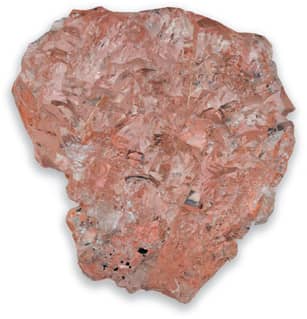
THE CRYSTAL
 Morganite is the pink variety of beryl. It is known for its transparent pink color, often soft pink, violet-pink, or pale salmon. In rare cases, it can display chatoyancy (resembling the band of reflected light in a cat's eye), and is often cut to highlight this effect.
Morganite is the pink variety of beryl. It is known for its transparent pink color, often soft pink, violet-pink, or pale salmon. In rare cases, it can display chatoyancy (resembling the band of reflected light in a cat's eye), and is often cut to highlight this effect.
LEGENDARY USES
Discovered in California in the early 1900s and, soon after, on Madagascar, the crystal was known as pink beryl until 1911 when, at the suggestion of George F. Kunz, then chief gemologist at Tiffany & Co., it was renamed morganite. This was in honor of a Tiffany patron, the financier and gem collector J. P. Morgan, for his gemological and mineral contributions to the American Museum of Natural History in New York.
ATTRIBUTES AND POWERS
Morganite promotes determination, commitment, and caring. Its soothing color calms feelings of anger or resentment. Pink is also the color of new love, new romance, and new relationships. Wearing the stone increases sensual love, and can help overcome heartache. Morganite also attracts abundant love into your life, and helps to maintain that love with positive thoughts and actions. As a crystal of manifestation, it may be used to attract one’s soulmate or deepen a current relationship. It inspires joy and reverence for life and encourages one to move forward with renewed purpose and an open heart.
PEARL
APPEARANCE/COLOR: White, pearl luster
CURRENT AVAILABILITY: Common
PHYSIOLOGICAL CORRESPONDENCE: Ovaries, womb
PSYCHOLOGICAL CORRESPONDENCE: Truth, fidelity
ASSOCIATED CRYSTALS BY COLOR: Moonstone, opal
KEYWORDS: Vitalizing feminine power to attract love
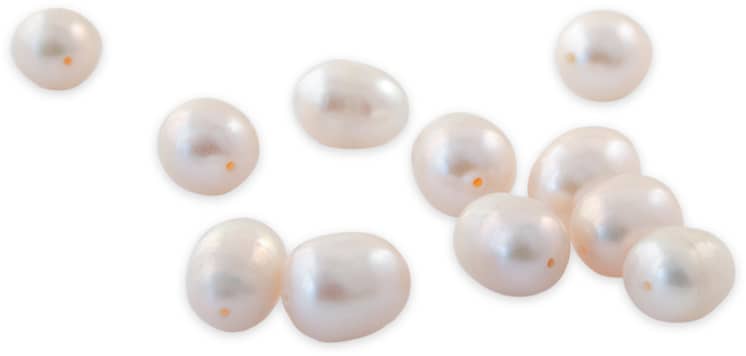
THE CRYSTAL
 Unlike crystals that form in the Earth, pearls grow in oysters and mussels. When a grain of sand or other irritant gets inside the shell, the mollusk secretes layer upon layer of nacre around the irritant until it gradually builds up to form a pearl. Light reflecting from these overlapping layers produces the characteristic iridescent glow.
Unlike crystals that form in the Earth, pearls grow in oysters and mussels. When a grain of sand or other irritant gets inside the shell, the mollusk secretes layer upon layer of nacre around the irritant until it gradually builds up to form a pearl. Light reflecting from these overlapping layers produces the characteristic iridescent glow.
LEGENDARY USES
In ancient Vedic texts, the primeval forces of Heaven and Earth created the pearl. Before it floated into the Void, it was fertilized by a flash of lightning and became the daughter of the moon. Legend tells that Cleopatra only drank wine that was dusted with ground pearls to protect herself from poisoning. In the Bible’s Book of Job, there is a saying, “the price of wisdom is above pearls,” while Lucifer is said to have broken his teeth on pearls after being unable to resist trying to eat them.
ATTRIBUTES AND POWERS
Historically a symbol of purity, innocence, and faith, pearls enhance personal integrity and bring clarity, sincerity, truth, and loyalty. Said to stimulate one’s femininity and to assist in self-acceptance, wearing pearls can promote self-value and confidence, lifting your spirits and enhancing your feminine charm. Aligned to the moon's cycle, wearing pearls when the moon is waxing will help you to seduce new admirers to your side; worn during the waning moon, pearls can help you move a relationship toward a new beginning, or toward closure if that is what is truly desired.
PECTOLITE (BLUE)
APPEARANCE/COLOR: Soft blue or green
CURRENT AVAILABILITY: Widely available
PHYSIOLOGICAL CORRESPONDENCE: Cartilage
PSYCHOLOGICAL CORRESPONDENCE: Serenity, acceptance
ASSOCIATED CRYSTALS BY COLOR: Aquamarine, moss agate
KEYWORDS: Synchronicity, soulmate encounters
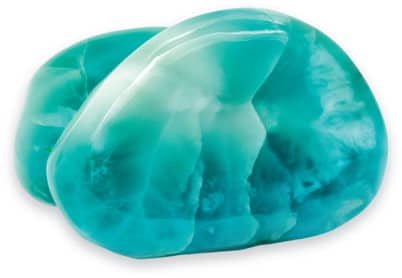
THE CRYSTAL
 Blue pectolite is the rare, gem-quality variety of the commonly occurring silicate mineral pectolite. It forms as needle-like crystals, grown together in a solid mass, and forms in cavities within basaltic lava. Copper or manganese intrusions produce beautiful translucent shades of soft blues with whorls or streaks of white.
Blue pectolite is the rare, gem-quality variety of the commonly occurring silicate mineral pectolite. It forms as needle-like crystals, grown together in a solid mass, and forms in cavities within basaltic lava. Copper or manganese intrusions produce beautiful translucent shades of soft blues with whorls or streaks of white.
LEGENDARY USES
Pectolite was first described in 1828 in the Italian Alps and as such there are no legends. Particularly fine quality pectolite can be found in New Jersey. Collectible light blue pectolite comes only from the Dominican Republic, where it is sold under its trademarked name, Larimar. In 1974, the Dominican who rediscovered it after its original find in 1916, used the first letters of his daughter's name, Larissa, and the Spanish word for the sea, mar, to create the name Larimar. Pectolite derives from the Greek words pektos, meaning “compacted,” and lithos, meaning “stone.”
ATTRIBUTES AND POWERS
As a soothing Water element stone, blue pectolite calms hot tempers and instills a sense of peace and serenity in the wearer. Blue pectolite is an excellent stone for finding a soulmate. Not only does it help to heal unresolved issues or fears, but also connects you to the cycles of nature, and the feminine principle. By doing so, the stone enables you to manifest true love and weave into the synchronicity of meeting your perfect partner. If you are looking for a stone which enables you to manifest positive change in your relationships—whether letting go of someone or restarting your life with someone new, this is a great stone to wear or carry.
QUARTZ (ROSE)
APPEARANCE/COLOR: Rose-pink
CURRENT AVAILABILITY: Common
PHYSIOLOGICAL CORRESPONDENCE: Heart
PSYCHOLOGICAL CORRESPONDENCE: Emotional healing
ASSOCIATED CRYSTALS BY COLOR: Rhodochrosite, pink tourmaline
KEYWORDS: Unconditional love, new romance
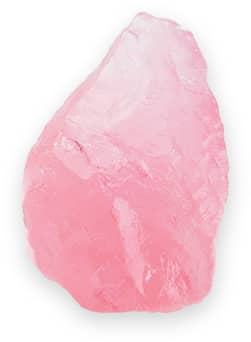
THE CRYSTAL
 Rose quartz, not to be confused with pink quartz, is a silicon dioxide crystal, and one of the most common varieties of the quartz family. It is found in abundance around the world and occurs only in massive form, with no crystal faces, edges, or terminations.
Rose quartz, not to be confused with pink quartz, is a silicon dioxide crystal, and one of the most common varieties of the quartz family. It is found in abundance around the world and occurs only in massive form, with no crystal faces, edges, or terminations.
LEGENDARY USES
Ancient Egyptians believed rose quartz would promote a perfect complexion, and it was ground to a fine powder to make facial masks. Also known as the “heart stone,” rose quartz has long been an important stone for carving love talismans and statues in the Far East and may have been used as a love token as early as 6000 BCE. According to one legend, when Adonis, lover of the Greek goddess Aphrodite, was attacked by the jealous Ares, god of war, Aphrodite tried to save Adonis and caught her arm on a thorn bush. As their mingled blood fell to earth, it stained clear quartz the rose-pink color.
ATTRIBUTES AND POWERS
Highly effective in attracting new love, romance, and intimacy, rose quartz is well known for its power to create a closer bond between lovers. If you are looking for love, rose quartz may also be placed by the bed or in the relationship corner of the home (the southwest) to restore trust and harmony, and to encourage unconditional love. As a stone of love, tenderness, and sensuality, rose quartz is a powerful aphrodisiac, stimulating sensual imagination. It helps to prevent fear or rejection, and allows you to see that love is about giving others space and not expecting too much too soon. However, if you want to manifest a new romance, this is the stone to carry or wear on a daily basis.
RHODOCHROSITE
APPEARANCE/COLOR: Pink, rose-red, orange
CURRENT AVAILABILITY: Easily obtained
PHYSIOLOGICAL CORRESPONDENCE: Respiration
PSYCHOLOGICAL CORRESPONDENCE: Emotional honesty
ASSOCIATED CRYSTALS BY COLOR: Pink tourmaline, rhodolite
KEYWORDS: Soul-mate attraction
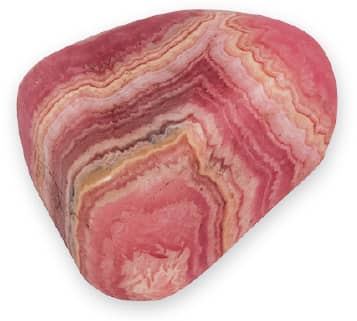
THE CRYSTAL
 Rhodochrosite is a manganese carbonate mineral of the calcite group. Its name derives from the Greek words rhodon, meaning “rose,” and khros, meaning “color,” referring to its vivid pink or rose-red color. It has a vitreous and pearly luster, often banded in layers ranging from white or light pink.
Rhodochrosite is a manganese carbonate mineral of the calcite group. Its name derives from the Greek words rhodon, meaning “rose,” and khros, meaning “color,” referring to its vivid pink or rose-red color. It has a vitreous and pearly luster, often banded in layers ranging from white or light pink.
LEGENDARY USES
Sometimes known as Inca rose, the stone was believed to have been discovered in the pre-Colombian 13th-century silver mines in what is now northern Argentina. One of the earliest Inca rulers, Viracocha, was credited with the discovery of the rose-red stone. Believing the stone to be formed from the blood of the Incas' ancestral founders, it was sacred to the people ever after. Another legend tells of how a cave deep inside the Andes is a secret home to a rhodochrosite heart-shaped boulder. It is believed to be the heart of Mother Earth, beating once every two hundred years.
ATTRIBUTES AND POWERS
Rhodochrosite emanates one of the most tender and loving energies of any stone, soothing the heart and comforting the soul. Symbolizing selfless love, wearing, carrying, or meditating with rhodochrosite frees you from emotional stress. It allows for spontaneous expression of feelings and can enhance passion and sexuality. Rhodochrosite is a great stone for manifesting new love in one’s life, whether a friend, romantic partner, or soulmate. Promoting success in your quest for emotional happiness, it can help you express love toward others without fear of rejection, allowing you to face the truth about yourself and others with loving awareness.
RHODOLITE
APPEARANCE/COLOR: Rose, raspberry red, pale violet
CURRENT AVAILABILITY: Widely available
PHYSIOLOGICAL CORRESPONDENCE: Blood circulation
PSYCHOLOGICAL CORRESPONDENCE: Trust, inspiration
ASSOCIATED CRYSTALS BY COLOR: Rhodoschrosite, rhodonite
KEYWORDS: Enhances sexuality, manifests desire
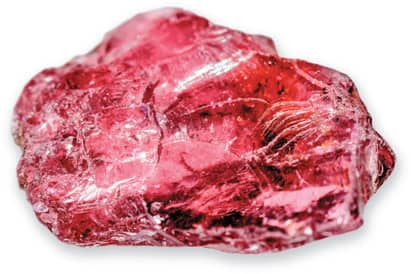
THE CRYSTAL
 Rhodolite is a mixture of two minerals, pyrope and almandine garnet. Its name is derived from the Greek words for “rose” and “stone.” It shimmers with all the brilliance and fire of the garnets, with colors ranging from rose through raspberry to pale violet.
Rhodolite is a mixture of two minerals, pyrope and almandine garnet. Its name is derived from the Greek words for “rose” and “stone.” It shimmers with all the brilliance and fire of the garnets, with colors ranging from rose through raspberry to pale violet.
LEGENDARY USES
Greek mythology speaks of rose-red garnets which, through the influence of the gods Zeus and Aphrodite, heal emotional rifts between lovers. In ancient India, garnets were used in weaponry because they were believed to have powerful magical powers to kill all evil. Victorian widows wore garnets to show their undying love for their departed spouses and luxury jewelers, including Fabergé and Tiffany, began to use rhodolite in their designs.
ATTRIBUTES AND POWERS
Known as a stone of inspiration, rhodolite stimulates one's sense of self-worth and awareness of one's own talents. It encourages love, kindness, and compassion, and promotes spiritual growth. Rhodolite soothes and heals the emotions, unblocking the inability to receive love. Light red or pink rhodolite brings the energy rays of determination, commitment, and caring. Its soothing color calms feelings of anger or resentment, and can help you to meditate and reflect. Wearing the pinker shades of rhodolite promotes charisma and desirability. The darker, raspberry variety of rhodolite will enhance all forms of sexual desire and encourage seductive encounters or physical relationships to flourish.
RHODONITE
APPEARANCE/COLOR: Red or pink
CURRENT AVAILABILITY: Easily available
PHYSIOLOGICAL CORRESPONDENCE: Bones, joints
PSYCHOLOGICAL CORRESPONDENCE: Self-love, confidence
ASSOCIATED CRYSTALS BY COLOR: Garnet, ruby
KEYWORDS: Passionate exchange
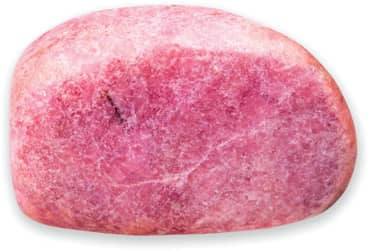
THE CRYSTAL
 Rhodonite commonly occurs as compact masses of rose-red stone (the name comes from the Greek rhodon, meaning "rosy"), streaked or layered with black or white veins showing the presence of manganese. The surface can sometimes tend toward a shade of brown because of oxidation.
Rhodonite commonly occurs as compact masses of rose-red stone (the name comes from the Greek rhodon, meaning "rosy"), streaked or layered with black or white veins showing the presence of manganese. The surface can sometimes tend toward a shade of brown because of oxidation.
LEGENDARY USES
In Russia up until the late 18th century this rose-red stone was known among the indigenous peoples of the Urals as the “eagle stone.” Observing eagles carrying pieces of the stone to build and protect their eyries, it became a local superstition to place an amulet inside a baby's crib to protect the child against evil. Prized by Russian tsars for making ornamental tableware and beautiful jewelry, it became the national stone of Russia in 1913.
ATTRIBUTES AND POWERS
As a stone that nurtures love, wearing or carrying rhodonite protects against envy and jealousy; it brings purpose, cooperation, and generosity of spirit. Rhodonite is highly recognized as an emotional healer and for acceptance of one's own emotional state. It grounds, stabilizes and brings self-confidence in all love relationships. Wearing the stone alerts you to circumstances where something, or someone, is not all it seems, providing the “wake-up call” needed to do something positive about it. Carry rhodonite to stop others blaming you for their own failings, and to see that revenge and retaliation are self-destructive. Wear the stone to transform any negative energy into true sexual union and passion between two lovers.
SAPPHIRE (PINK)
APPEARANCE/COLOR: Light pink
CURRENT AVAILABILITY: Available from specialty stores
PHYSIOLOGICAL CORRESPONDENCE: Circulatory system
PSYCHOLOGICAL CORRESPONDENCE: Emotional mastery
ASSOCIATED CRYSTALS BY COLOR: Pink tourmaline, rose quartz
KEYWORDS: Fast-acting love attractor
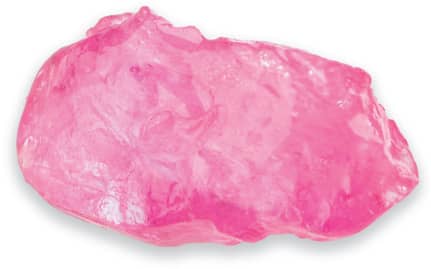
THE CRYSTAL
 Sapphire is a variety of corundum, an aluminum oxide mineral, and may be transparent or opaque. Pink corundum is now known as pink sapphire, and like ruby, it is colored by smaller amounts of chromium, producing a pale pink tone.
Sapphire is a variety of corundum, an aluminum oxide mineral, and may be transparent or opaque. Pink corundum is now known as pink sapphire, and like ruby, it is colored by smaller amounts of chromium, producing a pale pink tone.
LEGENDARY USES
Historically, pink sapphire was considered to be a pale ruby, a softer, lighter version of ruby’s passionate intensity. In medieval Europe, nobles and royalty wore the stone to alert them to possible poisoning: if the stone grew dark or cloudy, then evil was close by. It would only resume its pink color once the danger had passed. Not only was the wearer or carrier of this precious stone protected from all evils, but if a stone was placed in each of the four corners of a house, garden or vineyard, the area would be preserved from “lightning, tempests, and worms.”
ATTRIBUTES AND POWERS
Pink sapphire is a stone of emotional and psychic protection, one that also promotes determination and emotional courage. This beautiful crystal calms and soothes your heart and soul, and prevents you from “over-thinking” or seeing what you want to see in a romantic situation. With this stone you will always see the truth. Pink sapphire also heals past wounds and encourages compassion for others. Wearing or carrying the stone enhances your ability to be open about relationships and find joy in interacting with others. It enhances intuitive power, and acts as a magnet, drawing into your life romantic opportunities or lovers or partners who will help you evolve and grow into your true potential.
SUGILITE
APPEARANCE/COLOR: Shades of purple, violet, pink
CURRENT AVAILABILITY: Rare, but available from specialty stores
PHYSIOLOGICAL CORRESPONDENCE: Nervous system
PSYCHOLOGICAL CORRESPONDENCE: Alleviates sorrow, promotes forgiveness
ASSOCIATED CRYSTALS BY COLOR: Charoite, polite
KEYWORDS: Spiritual love; deep connection with others
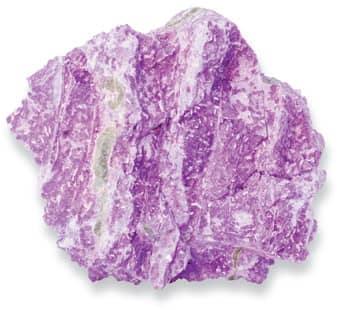
THE CRYSTAL
 Sugilite is a cyclosilicate mineral, crystallizing in a hexagonal system with prismatic crystals, although it is usually found as a mass. Mostly found in Japan and Canada, the best deposits of this violet stone come from very deep manganese mines in South Africa. Other common names of this stone include luvulite and lavulite.
Sugilite is a cyclosilicate mineral, crystallizing in a hexagonal system with prismatic crystals, although it is usually found as a mass. Mostly found in Japan and Canada, the best deposits of this violet stone come from very deep manganese mines in South Africa. Other common names of this stone include luvulite and lavulite.
LEGENDARY USES
Since sugilite was only first recorded in 1944, it has no ancient legends or lore associated with it. However, it became very popular in the 1980s, when it was known under its tradename Luvulite. The New Age market discovered its high vibration resonated with the coming “Age of Aquarius” and harnessed its energy to promote all forms of spiritual love. It was thought wearing the stone would enable you to recall your soul's true purpose, and to adapt to being in this incarnation. More recently it has become associated with self-love and forgiveness toward self and others.
ATTRIBUTES AND POWERS
Sugilite promotes love for self and others, and to let go of sorrow, frustration, past angers, and fear. It brings light and love into the darkest of situations, and fills you with joyful trust in the future. By enabling you to accept the “here and now,” sugilite instills confidence and a sense of freedom in personal relationships. Wearing or carrying sugilite creates an awareness that one is walking down the right pathway in life. Pink sugilite is a powerful love crystal and when worn as jewelry will attract kindred spirits and soulmates. The stone also dissolves unnecessary sentimentality in relationships, encouraging commitment in good times and bad.
TUGTUPITE
APPEARANCE/COLOR: Red, white, pink
CURRENT AVAILABILITY: Rare and fairly expensive
PHYSIOLOGICAL CORRESPONDENCE: Blood circulation
PSYCHOLOGICAL CORRESPONDENCE: Emotional security
ASSOCIATED CRYSTALS BY COLOR: Kunzite, red calcite
KEYWORDS: Protects from other's anger; romantic change for the better
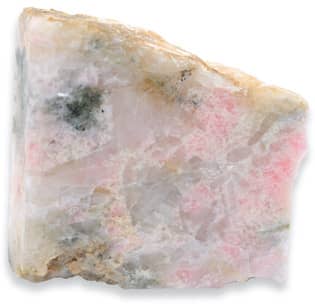
THE CRYSTAL
 Tugtupite is rare, and found primarily in, and named for, the region of Tugtup in Greenland. Tugtupite, meaning “reindeer blood stone” is similar in structure to sodalite (see here) and occurs in igneous rocks. The stone is tenebrescent, meaning its minerals are capable of changing color when exposed to sunlight.
Tugtupite is rare, and found primarily in, and named for, the region of Tugtup in Greenland. Tugtupite, meaning “reindeer blood stone” is similar in structure to sodalite (see here) and occurs in igneous rocks. The stone is tenebrescent, meaning its minerals are capable of changing color when exposed to sunlight.
LEGENDARY USES
Known to the Inuit peoples for thousands of years, there are several legends surrounding tugtupite and its ability to change color. One tells of how a female reindeer herder went into the mountains to give birth. As her blood fell, tugtupite formed and the stone was sacred ever after. Another legend tells that lovers turn the stone bright red with the fire of their passion, and that the stone stimulates the libido, and awakens forgotten love.
ATTRIBUTES AND POWERS
The stone helps you to develop self-love, and teaches you emotional independence, so rather than blame others for your reactions, you learn to own them. The stone transforms bitterness or anger into creative feelings. Wearing the stone means you can accept that romance changes and if you truly want love to start afresh or to be totally different, then you can now manifest those desires.
UNAKITE
APPEARANCE/COLOR: Various shades of green and pinkish red
CURRENT AVAILABILITY: Widely available
PHYSIOLOGICAL CORRESPONDENCE: Skin, hair
PSYCHOLOGICAL CORRESPONDENCE: Personal growth
ASSOCIATED CRYSTALS BY COLOR: Green beryl, pink agate
KEYWORDS: Togetherness, harmonious relating
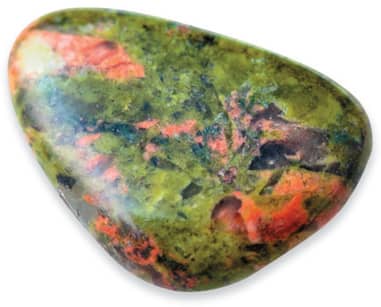
THE CRYSTAL
 Unakite is an altered granite and takes its name from the Unaka mountain range in North Carolina where it was first discovered. Composed of green epidote, pink feldspar, and colorless quartz, it also occurs in Africa, Brazil, and China, and is often found in glacial drift, including the deposits found around Lake Superior.
Unakite is an altered granite and takes its name from the Unaka mountain range in North Carolina where it was first discovered. Composed of green epidote, pink feldspar, and colorless quartz, it also occurs in Africa, Brazil, and China, and is often found in glacial drift, including the deposits found around Lake Superior.
LEGENDARY USES
The green epidote is the dominant mineral in unakite and its name derives from the Greek word epidosis, meaning “addition” or “growing together.” It is the blend of minerals that convey the stone's symbolic maxim: “That which comes together, belongs together.” Brazilian legends claim that anyone who carries the stone will be able to find things that have been lost. The stone can be found as pebbles on the shores of Lake Superior, where indigenous shamans used them to ensure success in casting magic spells.
ATTRIBUTES AND POWERS
The blend and union of the two elements symbolize strong, harmonious relationships. Its pink and green energies balance aspects of the heart, lifting spirits and helping to release negativity. Unakite fosters healthy relationships through balanced emotions. Encouraging harmonious partnerships, both in love and in business, it is especially helpful for working closely with partners, lovers, or friends, where positive personal interactions are vital. The stone promotes self-confidence, strengthens courage, and enhances your ability to bestow love and compassion on others as well as on yourself.
WATERMELON TOURMALINE
APPEARANCE/COLOR: Pink enfolded in green
CURRENT AVAILABILITY: Common
PHYSIOLOGICAL CORRESPONDENCE: Nervous system
PSYCHOLOGICAL CORRESPONDENCE: Self-expression, heals emotional wounds
ASSOCIATED CRYSTALS BY COLOR: Pink tourmaline, rose quartz
KEYWORDS: Unconditional loving and acceptance, sexual harmony
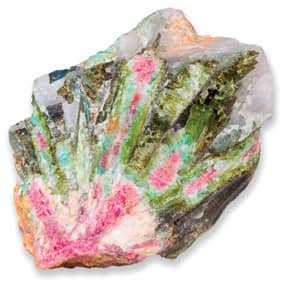
THE CRYSTAL
 Tourmalines are aluminum borosilicates that contain such metals as manganese and iron, which account for the huge variation in color across the group and often within a single specimen. The aptly named watermelon tourmaline is colored pink, white, and green within the same crystal. One of the stone's most distinguishing properties is that it is pyroelectric: that is, it has the ability to become electrically charged simply by heating or rubbing it. One end becomes positive and the other negative, allowing it to attract particles of dust.
Tourmalines are aluminum borosilicates that contain such metals as manganese and iron, which account for the huge variation in color across the group and often within a single specimen. The aptly named watermelon tourmaline is colored pink, white, and green within the same crystal. One of the stone's most distinguishing properties is that it is pyroelectric: that is, it has the ability to become electrically charged simply by heating or rubbing it. One end becomes positive and the other negative, allowing it to attract particles of dust.
LEGENDARY USES
Urban legends abound concerning a belief that tourmaline wands are being created in alchemical laboratories deep in the Andes. The enlightened beings who perform this magic charge the wands with cosmic power, which then “appear” in South American mines. These perfectly terminated wands may be a foot long and contain the full color spectrum. Vibrating simultaneously to all the chakras, they align our consciousness directly with universal knowledge. Once mined, these wands attract themselves to those who intuitively know how to use them.
ATTRIBUTES AND POWERS
A favorite among the tourmalines, the so-called watermelon variety is considered to energize and revitalize the heart chakra. While its pink layer is associated with love and emotional happiness, its green layer is beneficial to one’s physical being. Together they bring true joy to physical relationships. Wearing or carrying the stone cleanses you of destructive feelings and old wounds. It releases guilt, worry, depression, and anxieties, and diverts those emotions into self-love. It gives the emotionally inert a chance to recover their passion and zest for life, and helps the timid find the courage to love. The stone inspires new trust in others, and manifests happiness, joy, peace, and contentment.
ZIRCON
APPEARANCE/COLOR: Colorless, soft yellow, or pink
CURRENT AVAILABILITY: Widely available
PHYSIOLOGICAL CORRESPONDENCE: Liver and gallbladder
PSYCHOLOGICAL CORRESPONDENCE: Serenity, peace
ASSOCIATED CRYSTALS BY COLOR: Yellow sapphire, pink tourmaline
KEYWORDS: Attracts new love, romance and harmony
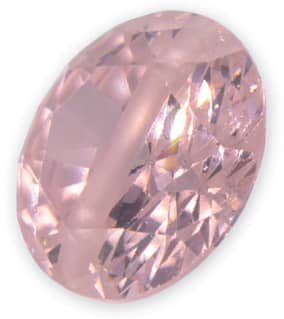
THE CRYSTAL
 Not to be confused with another diamond substitute, cubic zirconia, zircon is the mineral known as zirconium silicate. It occurs naturally in various colors—gold, blue, brown, green, and red—but it is the colorless specimens of zircon that are often used as a substitute for diamonds because they have similar properties of brilliance and fire.
Not to be confused with another diamond substitute, cubic zirconia, zircon is the mineral known as zirconium silicate. It occurs naturally in various colors—gold, blue, brown, green, and red—but it is the colorless specimens of zircon that are often used as a substitute for diamonds because they have similar properties of brilliance and fire.
LEGENDARY USE
Zircon was known in early Hindu mythology as one of the many gemstones on the mystical, wish-fulfilling kalpa tree—a green variety of zircon was thought to be the tree’s foliage. In ancient Greece, zircon was also called hyacinth or jacinth. One legend tells of the mythological youth, Hyacinthus, who was accidentally slain by his lover, the god Apollo. In his grief, Apollo turned the youth's blood into the hyacinth flower, whose beauty was forever after reflected in zircon. Wearing the stone was believed to drive away evil spirits and protect its wearer from enchantment and lightning.
ATTRIBUTES AND POWERS
Wearing or carrying zircon keeps love and romance “vivid,” passionate, real, and eternal, and promotes a harmonious loving energy around you to attract and manifest new love. The stone also promotes awareness of your true needs and desires in love, and brings you to a realization that your expectations of others may be too high. Placing zircon in the southwest area of your home will also bring you honest acceptance of how other people have their own dreams and desires too.